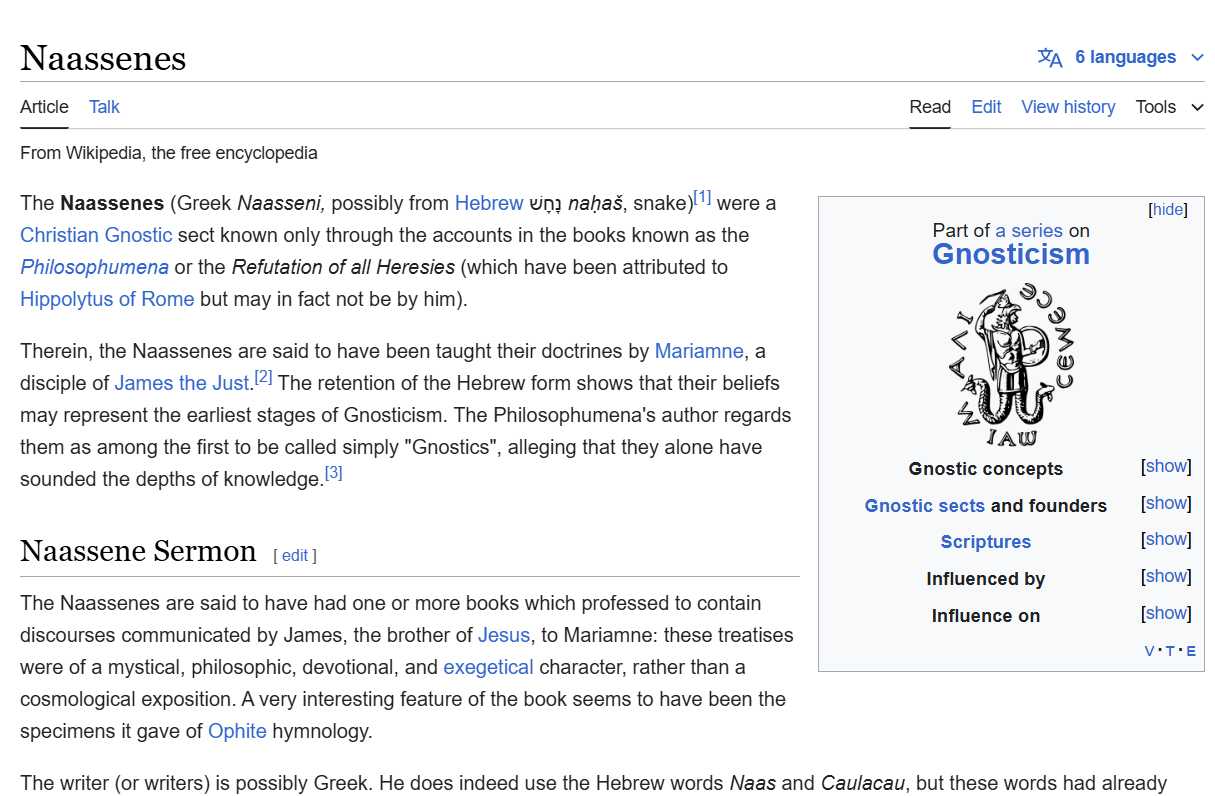
The Naassenes (Greek Naasseni, possibly from Hebrew נָחָשׁ naḥaš, snake)[1] were a Christian Gnostic sect known only through the writings of Hippolytus of Rome.
The Naassenes claimed to have been taught their doctrines by Mariamne, a disciple of James the Just.[2] The retention of the Hebrew form shows that their beliefs may represent the earliest stages of Gnosticism. Hippolytus regards them as among the first to be called simply "Gnostics", alleging that they alone have sounded the depths of knowledge.[3]
Naassene Sermon
The Naassenes had one or more books out of which Hippolytus of Rome largely quotes in the Philosophumena, which professed to contain heads of discourses communicated by James, the brother of Jesus, to Mariamne. They contained treatises of a mystical, philosophic, devotional, and exegetical character, rather than a cosmological exposition. A very interesting feature of the book seems to have been the specimens it gave of Ophite hymnology.
The writer (or writers) is possibly Greek. He does indeed use the Hebrew words Naas and Caulacau, but these words had already passed into the common Gnostic vocabulary so as to become known to many unacquainted with Hebrew. He shows a great knowledge of the religious mysteries of various nations. For instance, he dilates much on the Phrygian rites, and the whole section seems to be a commentary on a hymn to the Phrygian Attis.
Creation
The Naassene work known to Hippolytus would seem to have been of what we may call a devotional character rather than a formal exposition of doctrine, and this perhaps is why it is difficult to draw from the accounts left us a thoroughly consistent scheme. Thus, as we proceed, we are led to think of the first principle of nature, not as a single threefold being, but as three distinct substances; on the one hand the pre-existent, otherwise spoken of as the Good being, on the other hand the "outpoured Chaos," intermediate, between these one called Autogenes, and also the Logos. Chaos is naturally destitute of forms or qualities; neither does the preexistent being himself possess form, for though the cause of everything that comes into being, it is itself none of them, but only the seed from which they spring. The Logos is the mediator which draws forms from above and transfers them to the world below. Yet he seems to have a rival in this work; for we have reference made to a fourth being, whence or how brought into existence we are not told, a "fiery God," Esaldaios, the father of the idikos kosmos. That is to say, it was this fiery being, the same who appeared to Moses in the burning bush, who gave forms to the choical or purely material parts of nature. It is he who supplies the fiery heat of generation by which these forms are still continued. In this work the Logos had no part, for "all things were made through him, and without him was made nothing." The "nothing" that was made without him is the kosmos idikos. On the other hand, it is the Logos, who is identified with the serpent, and this again with the principle of Water, who brings down the pneumatic and psychical elements, so that through him man became a living soul. But he has now to do a greater work, namely, to provide for the release of the higher elements now enslaved under the dominion of matter, and for their restoration to the good God.[citation needed]
The serpent
Every temple, naos, shows by its title that it is intended for the honour of the serpent naas as "the Moist Essence," of the universe, without which "naught at all of existing things, immortal or mortal, animate or inanimate, can hold together." Furthermore, "all things are subject to Him, and He is Good, and has all things in Him ... so that He distributes beauty and bloom to all that exist according to each one's nature and peculiarity, as though permeating all."[14]
G.R.S. Mead has suggested that all of this is in reference to the Kundalini:—
This is the cosmic Akāsha of the Upaniṣhads, and the Kuṇḍalinī, or serpentine force in man, which when following animal impulse is the force of generation, but when applied to spiritual things makes of a man a god. It is the Waters of Great Jordan flowing downwards (the generation of men) and upwards (the generation of gods); the Akāsha-gangā or Heavenly Ganges of the Purāṇas, the Heavenly Nile of mystic Egypt.[15]

The Naassene Fragment is a fragmentary text that survives in no document except a quotation in the early third century encyclopedia of heresies by Hippolytus of Rome called Refutation of All Heresies (5.7.2-9). It may be considered part of the New Testament apocryphal tradition. The Naassenes (from Hebrew nachash, snake) were a Gnostic Ophite sect. The fragmentary quotation is given by Hippolytus as expressing the fundamental ideas of the Naassene Ophites, and possibly of all Gnostics.
Translation by G.R.S. Mead:
First [was there] Mind the Generative Law of All;
Second to the Firstborn was Liquid Chaos;
Third Soul through toil received the Law.
Wherefore, with a deer's form surrounding her,
She labours at her task beneath Death's rule.
Now,
holding sway, she sees the Light;
And now, cast into piteous plight, she weeps;
Now she weeps, and now rejoices;
Now she weeps, and now is judged;
Now is judged, and now she dieth;
Now is born, with
no way out for her; in misery
She enters in her wandering the labyrinth of ills.
And Jesus said: O Father, see!
[Behold] the struggle still of ills on earth!
Far from Thy Breath away she wanders!
She
seeks to flee the bitter Chaos,
And knows not how she shall pass through.
Wherefore, send me, O Father!
Seals in my hands, I will descend;
Through Æons universal will I make a Path;
Through Mysteries
all I'll open up a Way!
And Forms of Gods will I display;
The secrets of the Holy Path I will hand on,
And call them Gnosis.
Adolf von Harnack
The following is Adolf von Harnack's paraphrase (SBA, 1902, pp. 542 sqq.):
The generating principle of the universe, the first in order, was 'reason'; but the second principle was the firstbom's emitted 'chaos'; and the third principle was received by the soul, which descends from both. Therefore, fashioned like a trembling deer, the soul wrests herself free from the grip of death (strengthening itself by such exertions). Now she wins the mastery and sees the light; now plunged into wo, she weeps; again, in the depths of evil, the unhappy one becomes ensnared in a maze. Then spake Jesus: "behold, O Father! this being, pursued by ills, roams astray upon earth, far from thy breath. It seeks to escape bitter chaos, and knows not whither to find escape. Therefore, send me, O Father, with the seals in my hand will I descend: all eons will I traverse, all mysteries reveal, and show the forms of the gods. I will deliver the secret of the holy way, and call it Gnosis."
Here, reason and chaos, the intelligent and the material world, stand opposed; and between them is the human soul, belonging to both spheres, yet striving toward the higher and the spiritual. The soul is unable to ascend by its own power; therefore, a heavenly being, concordant with the will of the supreme principle, descends into the human world and redeems the soul by showing it the way through the spheres which sunder it from the world divine. It is not mere thirst for knowledge that impels the Gnostics, but essentially a concern of salvation; because the Gnostic's salvation depends on the possession of the Gnosis respecting these things.
Like Gnosis at large, the Ophites teach the existence of a Supreme Being, standing infinitely high above the visible world; qualified as purely spiritual, the primal basis of all things, the starting-point of the cosmic process. His names are, Father of the Universe, First Man, the "Uncreated," the "Unspeakable," the "Unapproachable God." He is self-evolving, and thus becomes the source of all being. The first products of this spontaneous evolution still belong to the purely spiritual spheres. The Ophitic theology tends to separate this supreme God into an ever-increasing number of separate entities. In the aforesaid Hymn, only the Son is mentioned beside the Father; but a tetrad occurs among the Ophites of Irenaeus and the Naassenes; an entire decad among the Gnostici Barbelo; while the Nag Hammadi writings disclose a countless host of higher beings. The Supreme Being's mode of evolution is set forth, now as a generative, again as a psychologic process; and frequently the two ideas are combined. Some pagan mythology lies obviously at the root of the matter; which accounts also for their syzygial views; for, in part at least, the Ophites aimed to interpret the ancient myths as psychologic processes. Over against the Supreme Being stands chaos, the material principle. Yet there is not here a sharp dualism. In the Hymn, the phrase "the firstborn's emitted chaos" implies that it is derived from a higher being. In only very few instances is chaos an evil power, an active principle. It is not the existence of chaos which contradicts perfection; but rather the mixture of luminous parts with material elements. This mixture, in a word, is the great calamity, the loss that must be retrieved through redemption. How did this mixture come to pass? The Hymn designates the soul, the principle of this compound, as the common product of mind and chaos. Such is also the theory of the Perates and Sethians, mentioned by Hippolytus. These sects most nearly approach the dualistic scheme, yet the latter is not distinctly defined. In Justin, also, dualism is diminished.
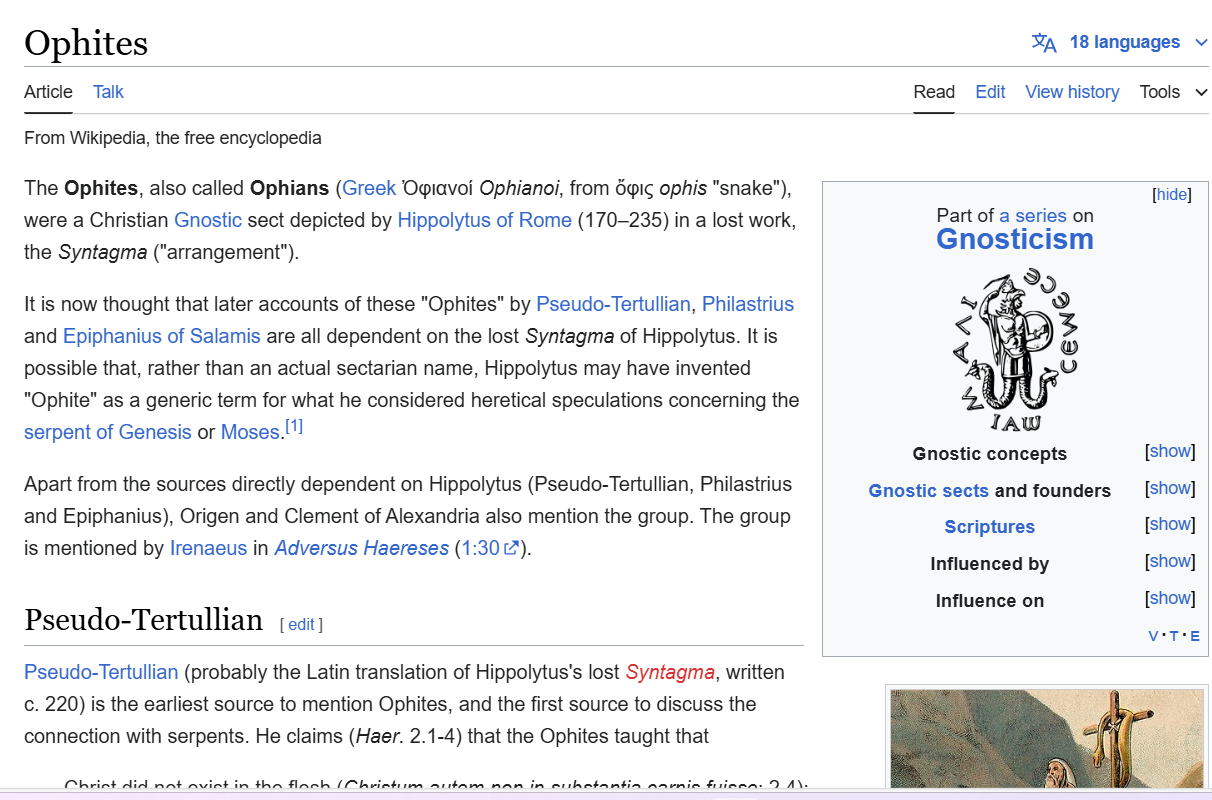
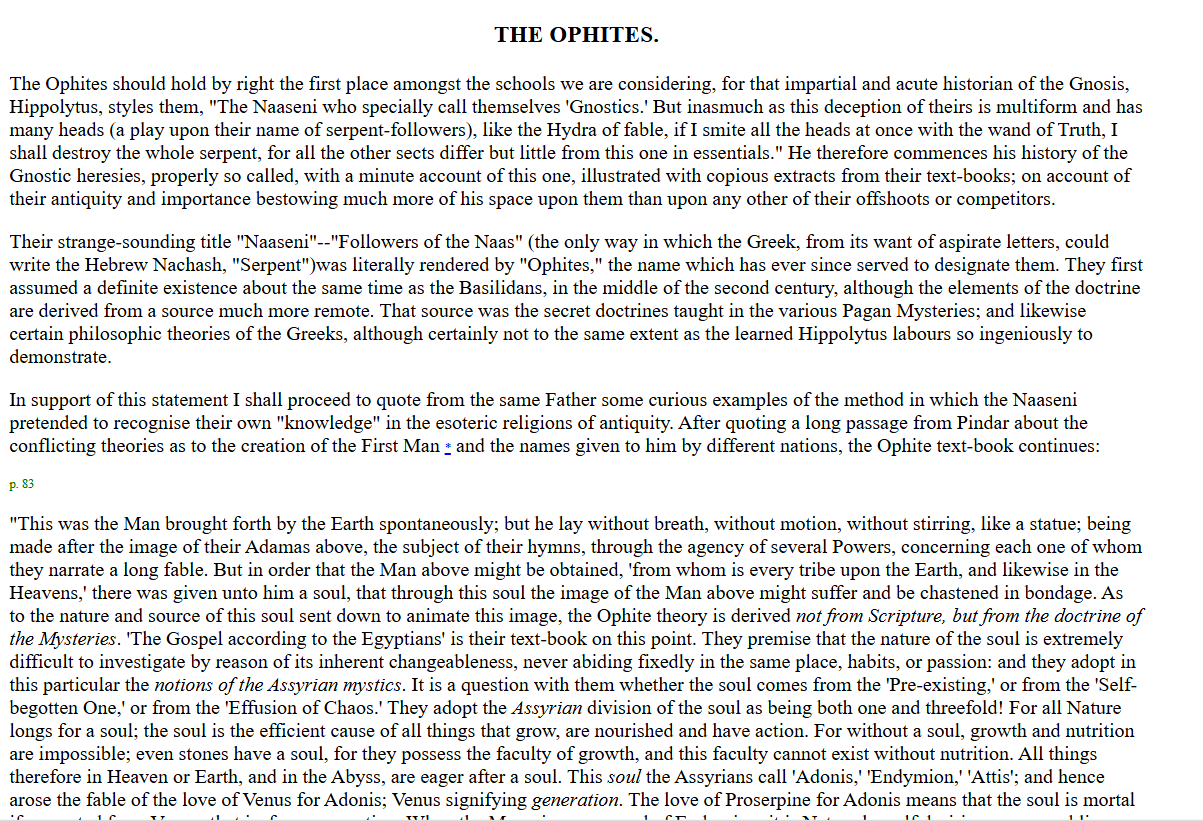
The Ophites, also called Ophians (Greek Ὀφιανοί Ophianoi, from ὄφις ophis "snake"), were a Christian Gnostic sect depicted by Hippolytus of Rome (170–235) in a lost work, the Syntagma ("arrangement").
It is now thought that later accounts of these "Ophites" by Pseudo-Tertullian, Philastrius and Epiphanius of Salamis are all dependent on the lost Syntagma of Hippolytus. It is possible rather than an actual sectarian name Hippolytus may have invented "Ophite" as a generic term for what he considered heretical speculations concerning the serpent of Genesis or Moses.[1]
Apart from the sources directly dependent on Hippolytus (Pseudo-Tertullian, Philastrius and Epiphanius), Origen and Clement of Alexandria also mention the group. The group is mentioned by Irenaeus in Adversus Haereses (1:30).
TERTUL.LIAN
Tertullian (probably the Latin translation of Hippolytus's lost Syntagma, written c. 220) is the earliest source to mention Ophites, and the first source to discuss the connection with serpents. He claims (Haer. 2.1-4) that the Ophites taught that
Christ did not exist in the flesh (Christum autem non in substantia carnis fuisse; 2.4); that they extolled the serpent and preferred it to Christ (serpentem magnificant in tantum, ut ilium etiam ipsi Christo praeferant; 2.1); and that Christ imitated (imitor) Moses' serpent's sacred power (Num 21:6-9) saying, "And just as Moses lifted up the serpent in the wilderness, so must the Son of Man be lifted up (John 3:14)" (Haer. 2:1). In addition, Eve is said to have believed the serpent, as if it had been God the Son (Eua quasi filio deo crediredat; 2.4).
The name "Jesus" is not mentioned in the account. Epiphanius's account differs from that of Pseudo-Tertullian only in a few places. According to the forme
EPIPHANIUS
They have a snake, which they keep in a certain chest—the cista mystica—and which at the hour of their mysteries they bring forth from its cave. They heap loaves upon the table and summon the serpent. Since the cave is open it comes out. It is a cunning beast and, knowing their foolish ways, it crawls up on the table and rolls in the loaves; this they say is the perfect sacrifice. Wherefore, as I have been told, they not only break the bread in which the snake has rolled and administer it to those present, but each one kisses the snake on the mouth, for the snake has been tamed by a spell, or has been made gentle for their fraud by some other diabolical method. And they fall down before it and call this the Eucharist, consummated by the beast rolling in the loaves. And through it, as they say, they send forth a hymn to the Father on high, thus concluding their mysteries.
Ophite teaching was, most likely, dying out in the days of Hippolytus; in the time of Epiphanius it was not absolutely extinct, but the notices in his work would lead us to think of it as but the eccentric doctrine of some stray heretic here and there, and not to have counted many adherents. In the 5th century Theodoret tells (Heresies 1:24) of having found serpent worship practised in his diocese by people whom he calls Marcionites, but whom we may believe to have been really Ophites.
The Ophites should hold by right the first place amongst the schools we are considering, for that impartial and acute historian of the Gnosis, Hippolytus, styles them, "The Naaseni who specially call themselves 'Gnostics.' But inasmuch as this deception of theirs is multiform and has many heads (a play upon their name of serpent-followers), like the Hydra of fable, if I smite all the heads at once with the wand of Truth, I shall destroy the whole serpent, for all the other sects differ but little from this one in essentials." He therefore commences his history of the Gnostic heresies, properly so called, with a minute account of this one, illustrated with copious extracts from their text-books; on account of their antiquity and importance bestowing much more of his space upon them than upon any other of their offshoots or competitors.
Their strange-sounding title "Naaseni"--"Followers of the Naas" (the only way in which the Greek, from its want of aspirate letters, could write the Hebrew Nachash, "Serpent")was literally rendered by "Ophites," the name which has ever since served to designate them. They first assumed a definite existence about the same time as the Basilidans, in the middle of the second century, although the elements of the doctrine are derived from a source much more remote. That source was the secret doctrines taught in the various Pagan Mysteries; and likewise certain philosophic theories of the Greeks, although certainly not to the same extent as the learned Hippolytus labours so ingeniously to demonstrate.
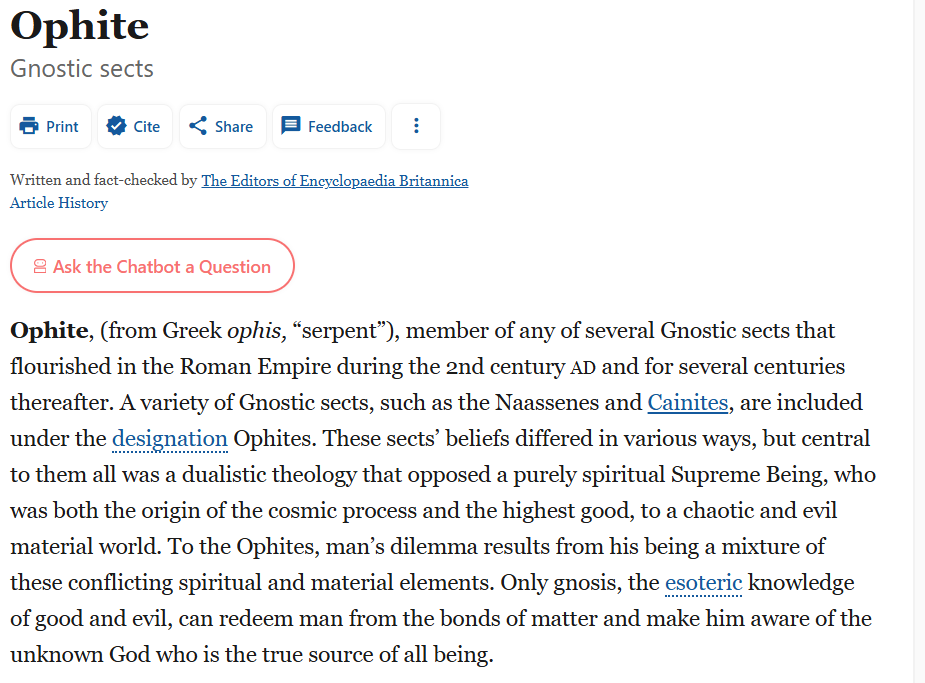
- Ophite, (from Greek ophis, “serpent”), member of any of several Gnostic sects that flourished in the Roman Empire during the 2nd century AD and for several centuries thereafter. A variety of Gnostic sects, such as the Naassenes and Cainites, are included under the designation Ophites. These sects’ beliefs differed in various ways, but central to them all was a dualistic theology that opposed a purely spiritual Supreme Being, who was both the origin of the cosmic process and the highest good, to a chaotic and evil material world. To the Ophites, man’s dilemma results from his being a mixture of these conflicting spiritual and material elements. Only gnosis, the esoteric knowledge of good and evil, can redeem man from the bonds of matter and make him aware of the unknown God who is the true source of all being.
The Ophites regarded the Jehovah of the Old Testament as merely a demiurge, or subordinate deity who had created the material world. They attached special importance to the serpent in the biblical book of Genesis because he had enabled men to obtain the all-important knowledge of good and evil that Jehovah had withheld from them. Accordingly, the serpent was a true liberator of mankind since he first taught men to rebel against Jehovah and seek knowledge of the true, unknown God. The Ophites further regarded the Christ as a purely spiritual being who through his union with the man Jesus taught the saving gnosis.
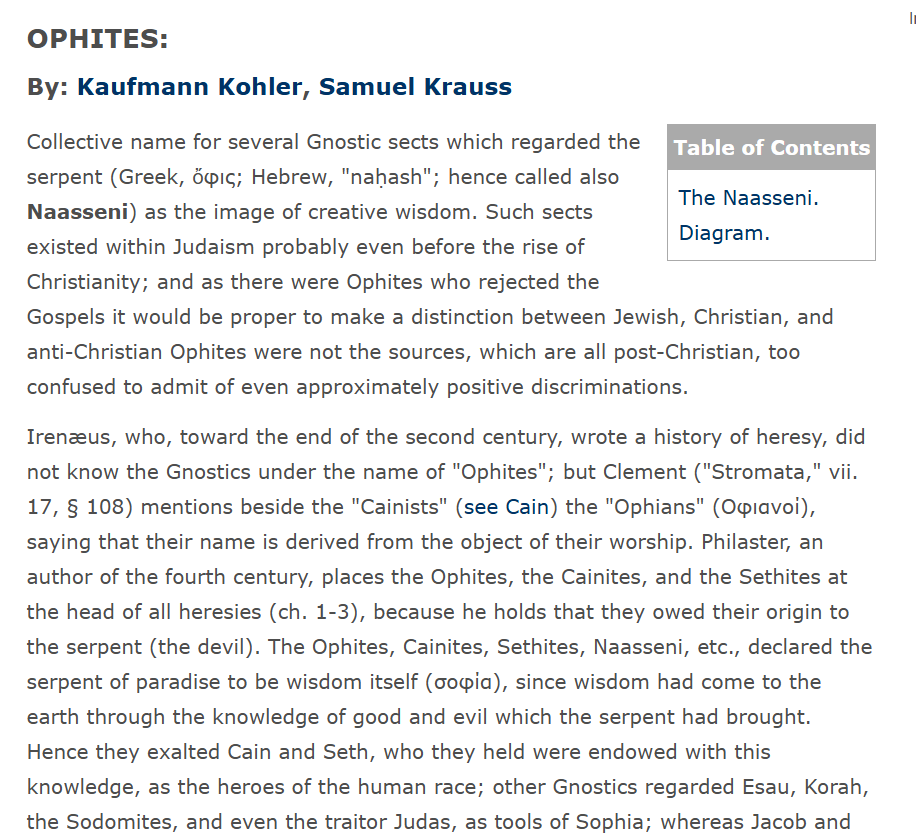
Collective name for several Gnostic sects which regarded the serpent (Greek, ὄφις; Hebrew, "naḥash"; hence called also Naasseni) as the image of creative wisdom. Such sects existed within Judaism probably even before the rise of Christianity; and as there were Ophites who rejected the Gospels it would be proper to make a distinction between Jewish, Christian, and anti-Christian Ophites were not the sources, which are all post-Christian, too confused to admit of even approximately positive discriminations.
Irenæus, who, toward the end of the second century, wrote a history of heresy, did not know the Gnostics under the name of "Ophites"; but Clement ("Stromata," vii. 17, § 108) mentions beside the "Cainists" (see Cain) the "Ophians" (Οφιανοί), saying that their name is derived from the object of their worship. Philaster, an author of the fourth century, places the Ophites, the Cainites, and the Sethites at the head of all heresies (ch. 1-3), because he holds that they owed their origin to the serpent (the devil). The Ophites, Cainites, Sethites, Naasseni, etc., declared the serpent of paradise to be wisdom itself (σοφία), since wisdom had come to the earth through the knowledge of good and evil which the serpent had brought. Hence they exalted Cain and Seth, who they held were endowed with this knowledge, as the heroes of the human race; other Gnostics regarded Esau, Korah, the Sodomites, and even the traitor Judas, as tools of Sophia; whereas Jacob and Moses, for instance, who were the instruments of the Creator (Demiurgus), were regarded as being inferior (Irenæus, "Against Heresies," i. 31, § 2). All Ophistic circles believed in a demonic hebdomad (i.e., seven spirits under the dominion of the serpent) side by side with the holy hebdomad under Jaldabaoth. The last-mentioned is the son of fallen wisdom ("yalda bahut" = "son of chaos"), and from him proceeded, in successive generations, Jao ( ), Sabaot, Adoneus, Elœus, Oreus ("or" = "light"), and Astaphæus, which are said to be manifestations of the God of the Old Testament. The Ophites claimed that Moses himself had exalted Ophis by setting up the serpent, and that Jesus also had recognized it (comp. John iii. 14).
The Naasseni went even further, and the retention of the Hebrew name shows that their belief represents the oldest stage of the heresy. "Whoever says that the All proceeded from the One, errs; but whoever says, from Three, speaks truth and can explain the All. The first of these three is the blessednature of the sainted higher man, Adamas [strangely explained as "diamond"]; the second is the death below; the third is the unruled race that had its origin above, and to which belong Mariam, 'the sought one' (ἡ ζητσυμένη), Jothar (Jethro), the great sage, Sepphora, the seeing one, and Moses." The three words "Kavlakav," "Savlasav," and "Zeer Sham" (taken from Isa. xxviii. 10), they declare, indicate Adamas above, death below, and the Jordan flowing upward (Hippolytus, "Philosophumena," v. 8), and present the threefold division of the realm of blessedness or immortality
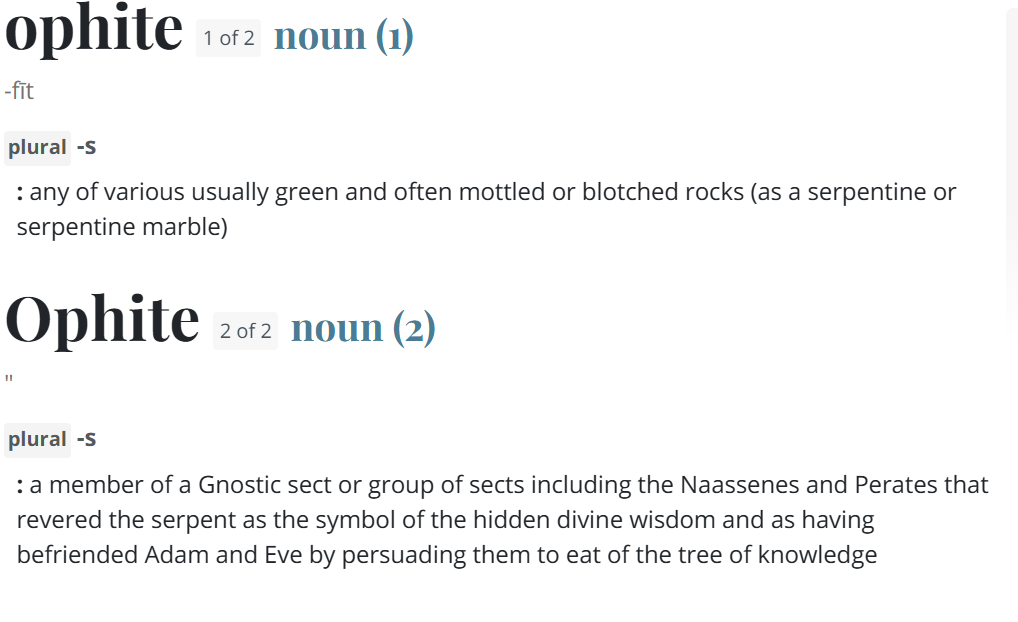
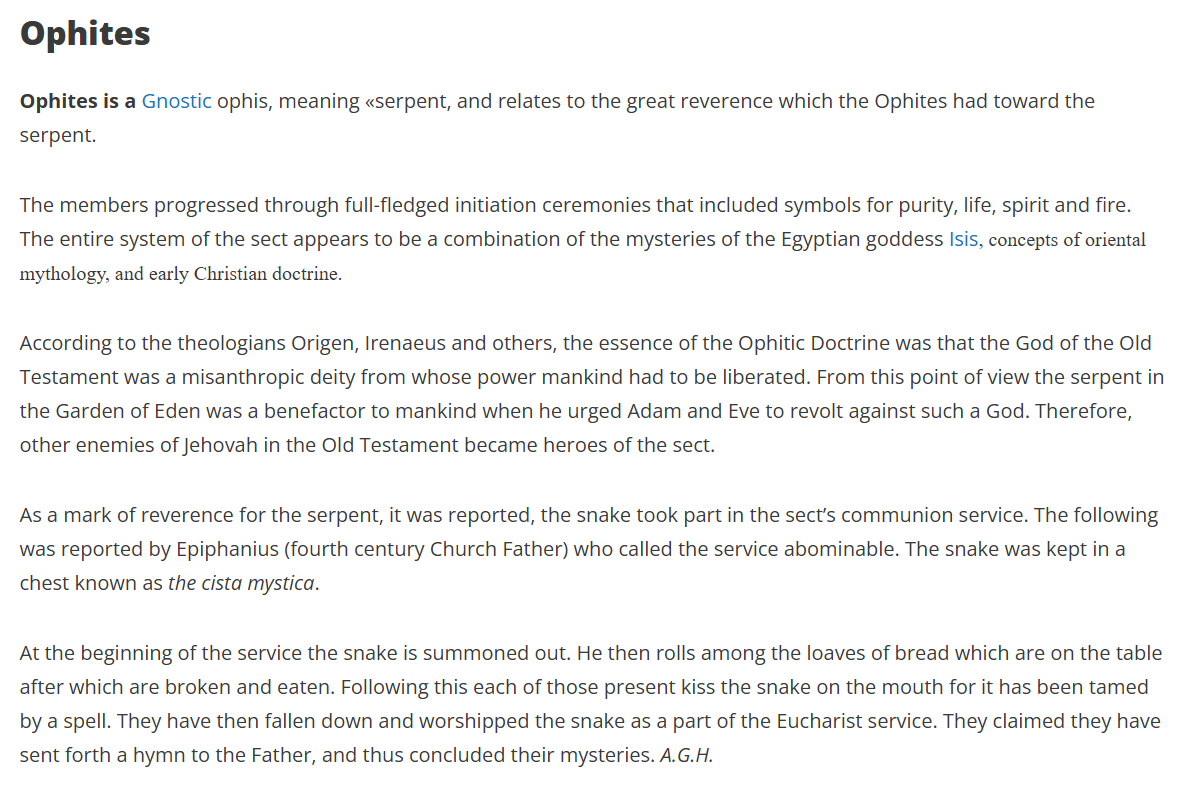
Ophites is a Gnostic ophis, meaning “serpent, and relates to the great reverence which the Ophites had toward the serpent.
The members progressed through full-fledged initiation ceremonies that included symbols for purity, life, spirit and fire. The entire system of the sect appears to be a combination of the mysteries of the Egyptian goddess Isis, concepts of oriental mythology, and early Christian doctrine.
According to the theologians Origen, Irenaeus and others, the essence of the Ophitic Doctrine was that the God of the Old Testament was a misanthropic deity from whose power mankind had to be liberated. From this point of view the serpent in the Garden of Eden was a benefactor to mankind when he urged Adam and Eve to revolt against such a God. Therefore, other enemies of Jehovah in the Old Testament became heroes of the sect.
As a mark of reverence for the serpent, it was reported, the snake took part in the sect’s communion service. The following was reported by Epiphanius (fourth century Church Father) who called the service abominable. The snake was kept in a chest known as the cista mystica.
At the beginning of the service the snake is summoned out. He then rolls among the loaves of bread which are on the table after which are broken and eaten. Following this each of those present kiss the snake on the mouth for it has been tamed by a spell. They have then fallen down and worshipped the snake as a part of the Eucharist service. They claimed they have sent forth a hymn to the Father, and thus concluded their mysteries. A.G.H.
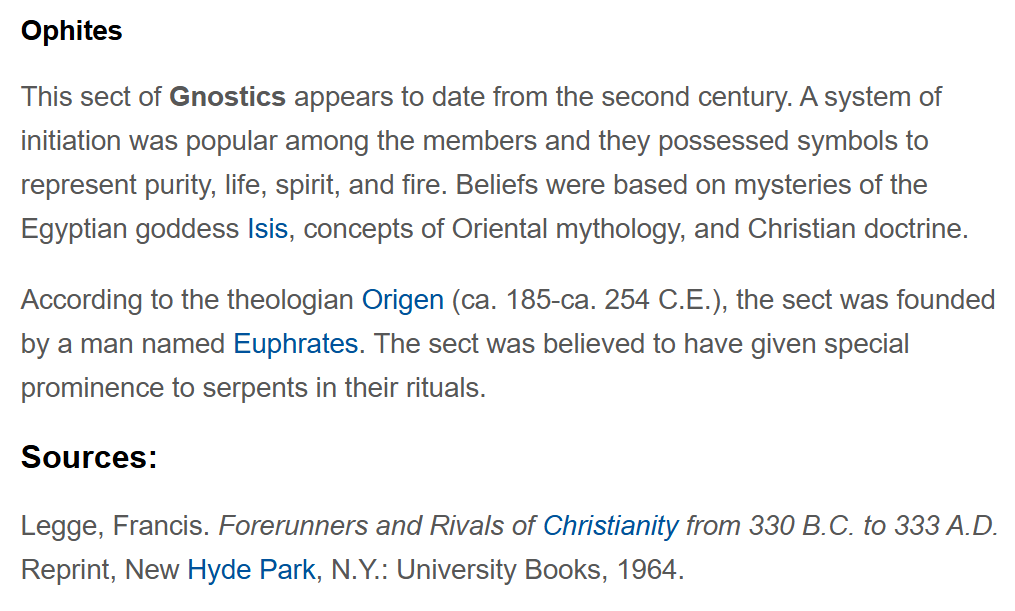
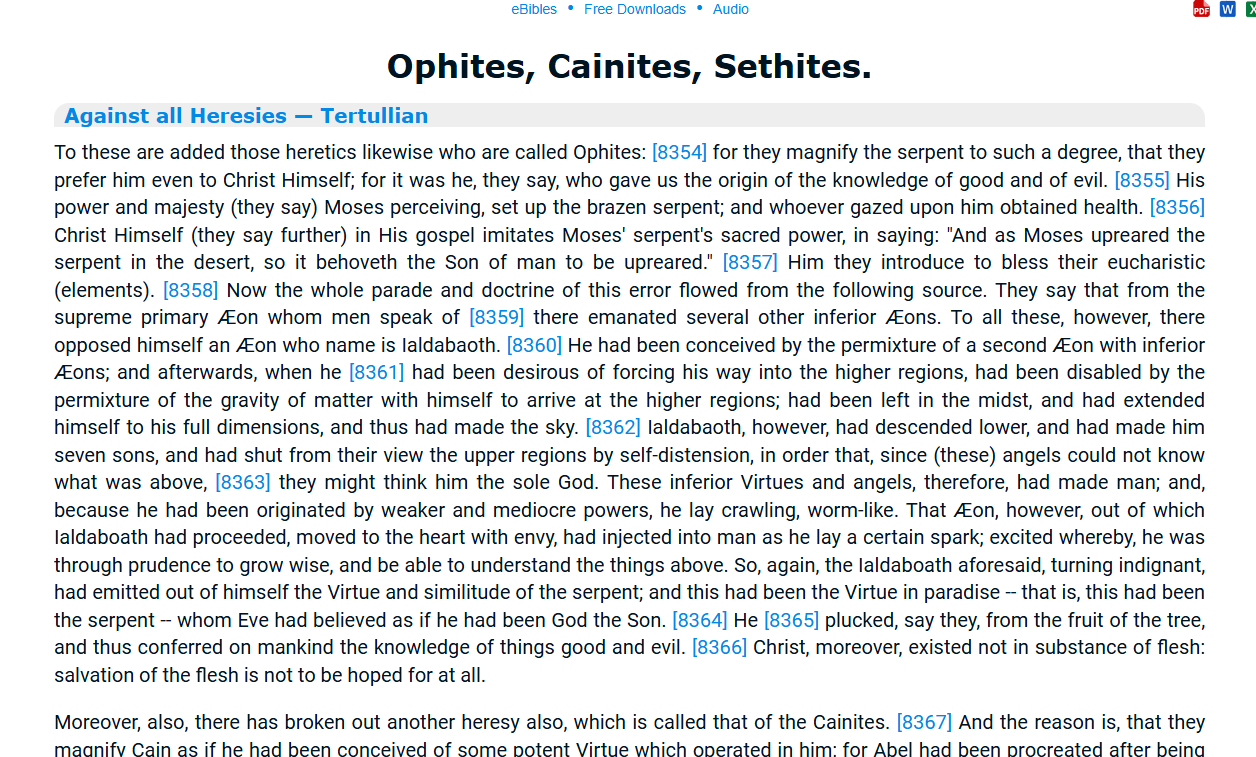
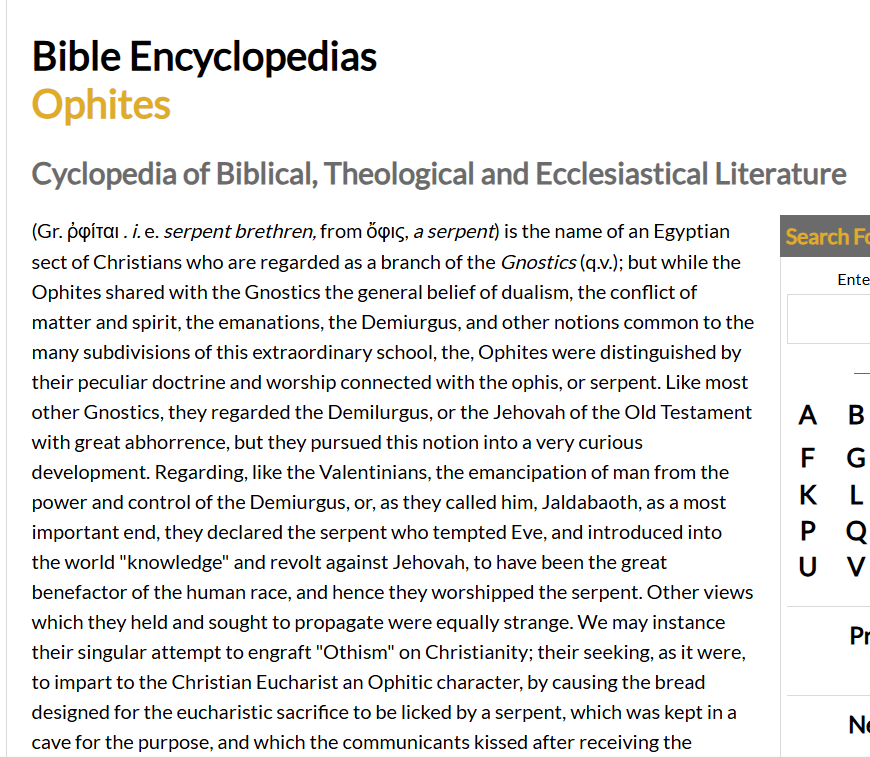
(Gr. ῤφίται . i. e. serpent brethren, from ὄφις, a serpent) is the name of an Egyptian sect of Christians who are regarded as a branch of the Gnostics (q.v.); but while the Ophites shared with the Gnostics the general belief of dualism, the conflict of matter and spirit, the emanations, the Demiurgus, and other notions common to the many subdivisions of this extraordinary school, the, Ophites were distinguished by their peculiar doctrine and worship connected with the ophis, or serpent. Like most other Gnostics, they regarded the Demilurgus, or the Jehovah of the Old Testament with great abhorrence, but they pursued this notion into a very curious development. Regarding, like the Valentinians, the emancipation of man from the power and control of the Demiurgus, or, as they called him, Jaldabaoth, as a most important end, they declared the serpent who tempted Eve, and introduced into the world "knowledge" and revolt against Jehovah, to have been the great benefactor of the human race, and hence they worshipped the serpent. Other views which they held and sought to propagate were equally strange. We may instance their singular attempt to engraft "Othism" on Christianity; their seeking, as it were, to impart to the Christian Eucharist an Ophitic character, by causing the bread designed for the eucharistic sacrifice to be licked by a serpent, which was kept in a cave for the purpose, and which the communicants kissed after receiving the Eucharist (Tertullian, Adv. Haeres. 2; Epiphanius, Hor. 37, § 5). Regarding Christ, they taught that he who was born of the Virgin was Jesus alone, and that afterwards Christ descended upon Jesus and in proof of this they pointed to the fact that Jesus wrought no miracle either before his baptism or after his resurrection.
The doctrines maintained by this sect in regard to the origin and destination of man are thus described by Neander: "The empire of Jaldabaoth is the starry world. The stars are the representatives and orians of the cosmical principle, which seeks to hold mans spirit in bondage and servitude, and to environ it with all manner of delusions. Jaldabaoth, and the six angels begotten by him, are the spirits of the seven planets, the Sun, the Moon, Mars, Vellnus, Jupiter, Mercuyl, and Saturn. It is the endeavor of Jaldabaoth to assert himself as self-subsistent Lord and Creator, to keep his six angels, from deserting their subjection, and, lest they should look up and observe the higher world of light, to fix their attention upon some object in another quarter. To this end he called upon the six angels to create man, after their own common image, as the crowning seal of their independent creative power. Man was created, and being in their own image, was a huge corporeal mass, but without a soul. He crept on the earth, and had not power to lift, himself erect. They therefore brought the helpless creature to their Father, that he might animate it with a soul. Jaldabaith breathed into it a living spirit, and thus, unperceived by himself, the spiritual seed passed from his owns being into the nature of man whereby he was deprived himself of this higher principle of life. Thus had the Sophia ordained it. In mann (i.e. those men who had received some portion of this spiritual seed) was concentrated the light, the soul, the reason of the whole creation. Jaldabaoth was now seized with amazement and wrath when he beheld a being created by himself, and within the bounds of his own kingdom, rising both above himself and his kingdom. He strove therefore to prevent man from becoming conscious of his higher nature, and of that higher order of world to which he had now become related — to keep him in a state of blind unconsciousness and thus of slavish submission. It was the jealousy of the contracted Jaldabaoth which issued that. command to the first man; but the mundane soul employed the serpent as an instrument to defeat the purpose of Jaldabaoth by tempting the first man to disobedience.
The Ophites originated in Egypt, probably from some relation to the Egyptian serpent-worship, and spread thence into Syria and Asia Minor. They continued to exist as a sect after other forms of Gnosticism had died out, the emperor Justinian enacting laws against them (Cod. i, v. 1, 18, 19, 21) so late as A.D. 530. Offshoots of them are the Cainites. (See SETHITES).
Cyprian mentions the Ophites (Ephesians 72:4); and the last chapter but one of Irenaeus's first book is supposed to have been written against them and the Sethians (Adv. Haeres. i, 30). Origen calls them "a very obscure sect," and denies that they were Christians, saying that "no person was allowed to join their assemblies till he had uttered curses against Jesus" (Contr. Cels. 3:13; 6,-24). He also says they were founded by a man named Euphrates (ibid. 11:28), a name mentioned by Theodoret as belonging to the founder of the heresy of the Peratee, but which in the account of the Naassen, or Ophites, given by Hippolytus is regarded as the name of the mystical water of life spoken of John 4:10. Hippolytus looks upon the Ophites as the originators of all heresies, and associates them with both Jews and the Gnostics; for he writes of them under the Hebrew form of their name as "the Naasseni," from נחשׁ (nachash, "a serpent"), "who call themselves Gnostics" (Hippol. Refut. v. 6). Philastes places them first in his list of heresies before Christ (De Haer. 1), while Epiphanius (Panar. 38) and Augustine (De Haer. 17) say that they were alleged to have been derived from the Nicolaitanes or the Gnostics. The heretical philosophy of the sect is given by Hippolytus and Epiphanius, as above quoted. The former says that they professed to derive it from James, the brother of our Lord, who handed it down to Mariamne. He also quotes from a "Gospel according to Thomas" which was in use among them, which seems to be the "Gospel according to the Egyptians" mentioned by Epiphanius in his twenty-sixth book among the Gnostic Apocrypha. In addition to these sources of information, there is also an account given by Origen of their "‘ Diagram," a tablet on which they set forth their doctrines in a hieroglyphical form (Contr. Cels. 6:33). See, besides the literature on Gnosticism, Pressense, Doctrines and Heresies of the Early Christian Church, p. 58; Werner, Gesch. d. rimisch. - kathol. Kirchenlehre;— Neander, Ch. Iist. vol. ii; id. Genetische Entwickelung des gnostischen Systems, p. 231 sq.; id. Hist. of Christian Dogmas, 1:178, 179; Haag, Histoire des Dogmes Chretiens, i, § 25; Walch, Gesch. der Ketzereien, 1:447 sq.; Milman, Hist. of Christianity; Liddoll, Divinity of Christ, 1:59, 143, 163; Schaff, Ch. Hist. vol. i; Hagenbach, Hist. of Doctrines; Baur, Die christl. Gnosis, p. 171 sq.; and his Das Christenthum der ersten drei Jahrhunderte, p. 176; Mosheim, Gesch. der Schlangenbruder (Helmst. 1748, 8vo); Schumacher, Lehrtofel der Ophiten (Wolfenb. -1755, 4t0); Fuldner, Commentaria de Ophitis; Jdcher, De Ophio-um heresi; Kille, Ophitarum mysteria retecta (Freib. 1822, 4to); Vogt, De Ophitis, in his Bibl. heresiol. 2:37 sq.; Wilke, De Oph. (Regiom. 1706); Schrockh, Kirchengesch. 2:409 sq. There is an article on the Ophitic System, by Lepsius, in the Zeitschr. fur wissenschaftliche Theologie, 1863, vol. iv; 1864, vol. 1.
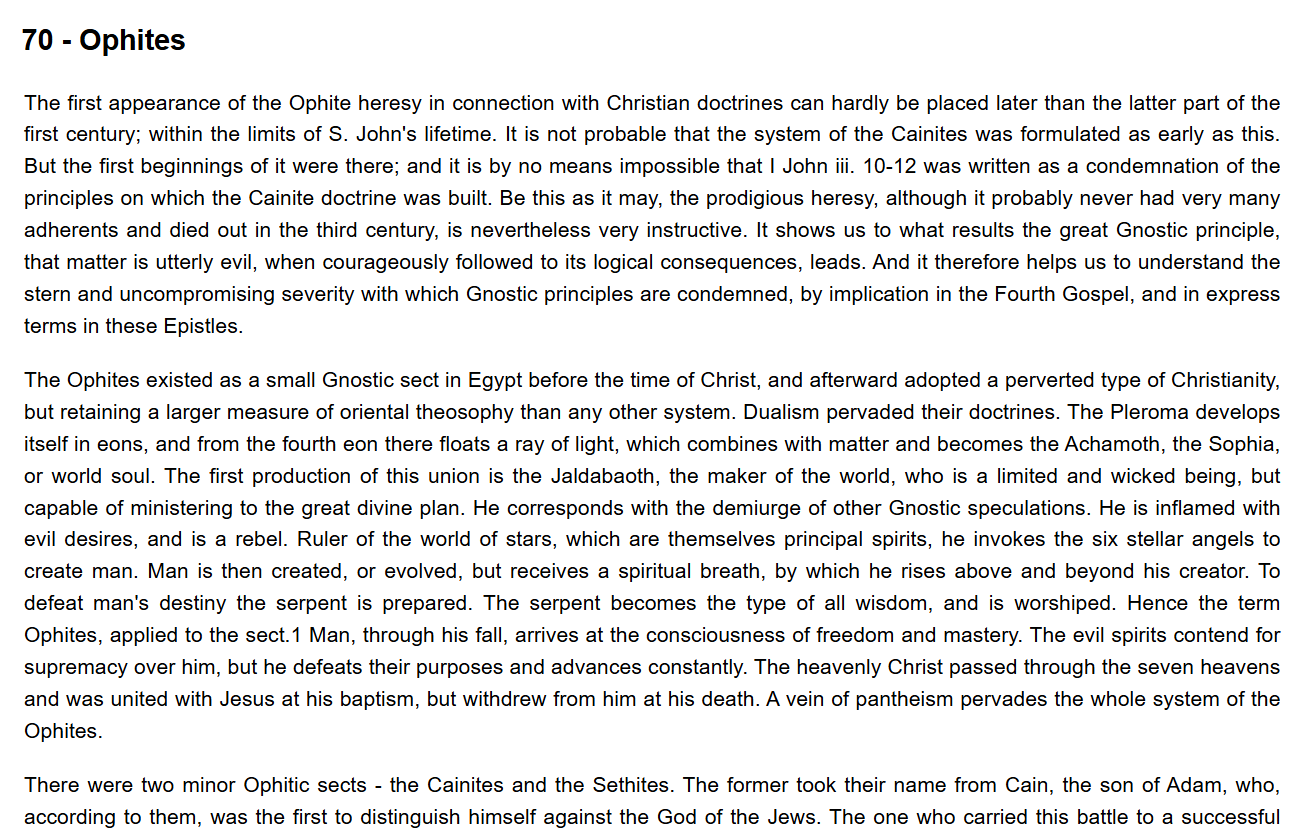
The first appearance of the Ophite heresy in connection with Christian doctrines can hardly be placed later than the latter part of the first century; within the limits of S. John's lifetime. It is not probable that the system of the Cainites was formulated as early as this. But the first beginnings of it were there; and it is by no means impossible that I John iii. 10-12 was written as a condemnation of the principles on which the Cainite doctrine was built. Be this as it may, the prodigious heresy, although it probably never had very many adherents and died out in the third century, is nevertheless very instructive. It shows us to what results the great Gnostic principle, that matter is utterly evil, when courageously followed to its logical consequences, leads. And it therefore helps us to understand the stern and uncompromising severity with which Gnostic principles are condemned, by implication in the Fourth Gospel, and in express terms in these Epistles.
The Ophites existed as a small Gnostic sect in Egypt before the time of Christ, and afterward adopted a perverted type of Christianity, but retaining a larger measure of oriental theosophy than any other system. Dualism pervaded their doctrines. The Pleroma develops itself in eons, and from the fourth eon there floats a ray of light, which combines with matter and becomes the Achamoth, the Sophia, or world soul. The first production of this union is the Jaldabaoth, the maker of the world, who is a limited and wicked being, but capable of ministering to the great divine plan. He corresponds with the demiurge of other Gnostic speculations. He is inflamed with evil desires, and is a rebel. Ruler of the world of stars, which are themselves principal spirits, he invokes the six stellar angels to create man. Man is then created, or evolved, but receives a spiritual breath, by which he rises above and beyond his creator. To defeat man's destiny the serpent is prepared. The serpent becomes the type of all wisdom, and is worshiped. Hence the term Ophites, applied to the sect.1 Man, through his fall, arrives at the consciousness of freedom and mastery. The evil spirits contend for supremacy over him, but he defeats their purposes and advances constantly. The heavenly Christ passed through the seven heavens and was united with Jesus at his baptism, but withdrew from him at his death. A vein of pantheism pervades the whole system of the Ophites.
There were two minor Ophitic sects - the Cainites and the Sethites. The former took their name from Cain, the son of Adam, who, according to them, was the first to distinguish himself against the God of the Jews. The one who carried this battle to a successful close was Judas Iscariot. Both Cain and Judas were rated by the Cainites as sons of the Sophia. The Sethites taught that there were originally two races of men, one from Cain and the other from Abel. Abel was defeated and slain, but, to take his place, the Sophia created the pueumatic Seth, the first of all the Gnostics. The second appearance of Seth was as the Christ, who came as Savior of the spiritual world.
The name of the extravagant Cainite Gnostic sect varies considerably in different authors who mention them: Cainistae, Caiani, Cainani, Cainaei, Cainiani, Caini, and possibly other varieties, are found. The Cainites were a branch of the Ophites, one of the oldest forms of Gnosticism known to us. Other branches of the Ophites known to us through Hippolytus are the Naassenes (Naash) or 'Venerators of the serpent,' the Peratae, 'Transmarines' or 'Transcendentalists,' the Sethians or 'Venerators of Seth,' and the Justinians or followers of Justin, a teacher otherwise unknown. Of these the Naassenes, as far as name goes, are the same as the Ophites, the one name being Hebrew, and the other Greek in origin, and both meaning 'Serpentists' or 'Venerators of the serpent.'
All the Ophite sects make the serpent play a prominent part in their system, and that not out of sheer caprice or extravagance, but as part of a reasoned and philosophical system. In common with almost all Gnostics they held that matter is radically evil, and that therefore the Creator of the material universe cannot be a perfectly good, being. The Ophites regarded the Creator as in the main an evil being, opposed to the Supreme God. From this it followed that Adam in disobeying his Creator did not fall from a high estate, nor rebelled against the Most High, but defied a hostile power and freed himself from its thraldom: and the serpent who induced him to do this, so far from being the author of sin and death, was the giver of light and liberty. It was through the serpent that the human race were first made aware that the being who created them was not supreme, but that there were higher than he; and accordingly the serpent became the symbol o1 intelligence and enlightenment.
The moral outcome of such a system has been already indicated, and the Cainites are said to have openly accepted it. Everything that the God of the Old Testament forbids must be practised, and everything that He orders abjured. Cain, the people of Sodom, Esau, Korah, Dathan and Abiram, are the characters to be imitated as saints and heroes; and in the New Testament, Judas. These are the true martyrs, whom the Creator and His followers have persecuted. About Judas, as about Jesus Christ, they seem not to have been agreed, some maintaining that he justly caused the death of one who perverted the truth; others, that having higher knowledge than 'the Eleven, he saw the benefits which would follow from the death of Christ, and therefore brought it about. These benefits, however, were not such as Christians commonly suppose, viz. the deliverance of mankind from the power of the serpent, but the final extinction of the dominion of the Creator.
Carpocrates built his system out of Buddhism and Neoplatonism. He placed all faiths on the same plane. The better men whom each produced - Orpheus, Pythagoras, Plato, Christ - occupied the same moral position. The Platonic system was the source of his ideology. He held to a preexistence of the soul, to a rule over the nations by finite spirits, from whom all the religions have come, and to a divine power in Jesus by which he wrought miracles and reached the highest unity. Carpocrates had a son, Epiphanes, who exerted such an influence and gained such a following that divine honors were paid him. The Carpocratians practiced magic and surrendered themselves to wild libertinism.
A late form of the Ophite heresy was one of the first to enter into rivalry with the Catholic Church. It seems to have sprung from a combination of the corrupt Judaism then practised in Asia Minor with the Pagan myths or legends prevalent all over Western Asia, which may some day be traced back to the Sumerians and the earliest civilizations. Yet the Ophites admitted the truth of the Gospel narrative, and asserted the existence of a Supreme Being endowed with the attributes of both sexes and manifesting Himself to man by means of a Deity called His son, who was nevertheless identified with both the masculine and feminine aspects of his Father. This triad, which the Ophites called the First Man, the Second Man, and the First Woman or Holy Spirit, they represented as creating the planetary worlds as well as the " world of form," by the intermediary of an inferior power called Sophia or Wisdom and her son Jaldabaoth, who is expressly stated to be the God of the Jews.
Hippolytus goes further than any other author by connecting these Ophite theories with the worship of the Mother of the Gods or Cybele, the form under which the triune deity of Western Asia was best known in Europe. Attis is, after the syncretistic fashion of post-Alexandrian paganism, identified with the Syrian Adonis, the Egyptian Osiris, the Greek Dionysos and Hermes, and the Samothracian or Cabiric gods Adamna and Corybas. The commentary of Hippolytus tried to explain or "interpret" the different myths there referred to by passages from the Old and New Testaments and from the Greek poets dragged in against their manifest sense and in the wildest fashion. Most of these supposed allusions, indeed, can only be justified by the most outrageous play upon words, and it may be truly said that not a single one of them when naturally construed bears the slightest reference to the matter in hand.
Cybele, called also Agdistis, Rhea, Ge, or the Great Mother, was said to have been born from a rock accidentally fecundated by Zeus. On her first appearance she was hermaphrodite, but on the gods depriving her of her virility it passed into an almond-tree. The fruit of this was plucked by the virgin daughter of the river Sangarios, who, placing it in her bosom, became by it the mother of Attis, fairest of mankind. Attis at his birth was exposed on the river-bank, but was rescued, brought up as a goatherd, and was later chosen as a husband by the king's daughter. At the marriage feast, Cybele, fired by jealousy, broke into the palace and, according to one version of the story, emasculated Attis who died of the hurt. Then Cybele repented and prayed to Zeus to restore him to life, which prayer was granted by making him a god. The ceremonies of the Megalesia celebrating the Death and Resurrection of Attis as held in Rome during the late Republic and early Empire.
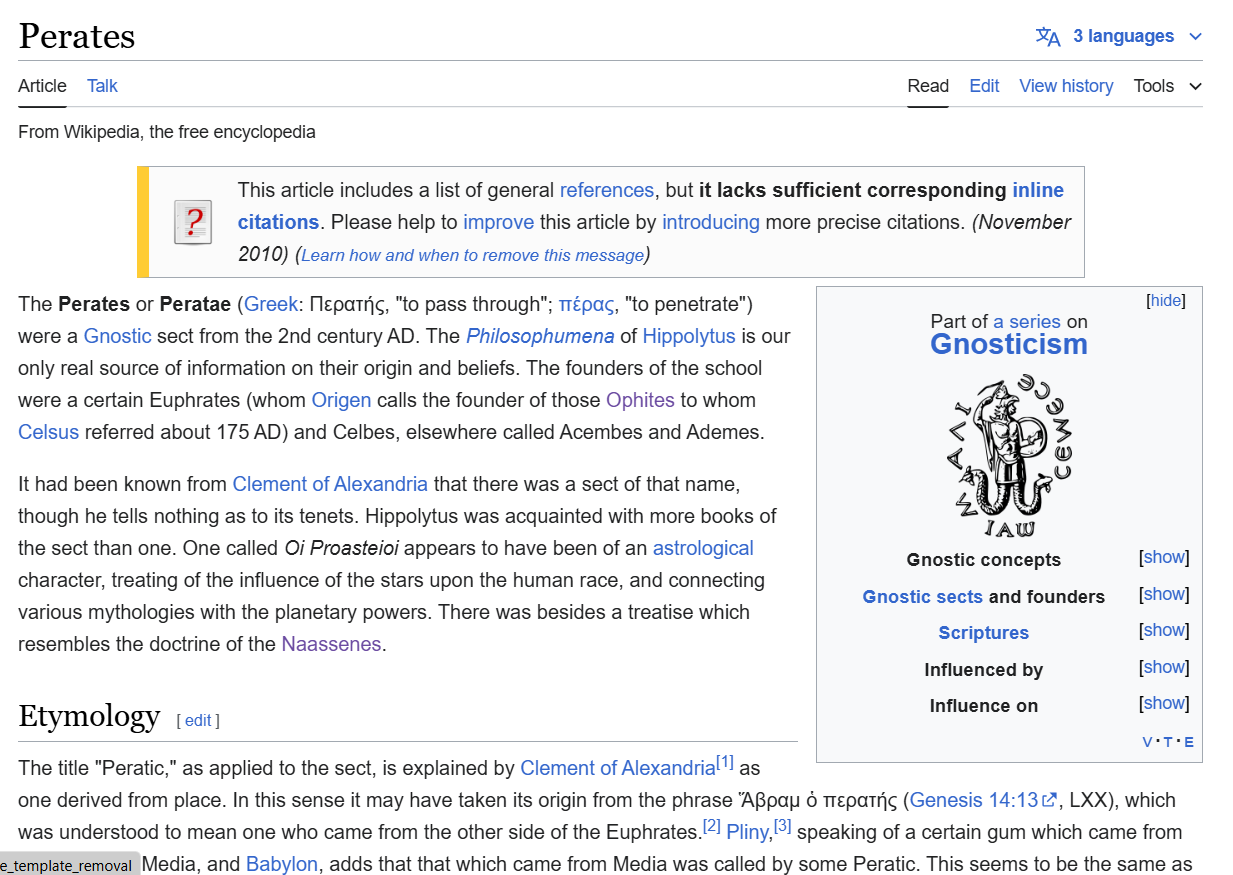
The Perates or Peratae (Greek: Περατής, "to pass through"; πέρας, "to penetrate") were a Gnostic sect from the 2nd century AD. The Philosophumena of Hippolytus is our only real source of information on their origin and beliefs. The founders of the school were a certain Euphrates (whom Origen calls the founder of those Ophites to whom Celsus referred about 175 AD) and Celbes, elsewhere called Acembes and Ademes.
It had been known from Clement of Alexandria that there was a sect of that name, though he tells nothing as to its tenets. Hippolytus was acquainted with more books of the sect than one. One called Oi Proasteioi appears to have been of an astrological character, treating of the influence of the stars upon the human race, and connecting various mythologies with the planetary powers. There was besides a treatise which resembles the doctrine of the Naassenes.
ETYMOLOGY
The title "Peratic," as applied to the sect, is explained by Clement of Alexandria[1] as one derived from place. In this sense it may have taken its origin from the phrase Ἅβραμ ὁ περατής (Genesis 14:13, LXX), which was understood to mean one who came from the other side of the Euphrates.[2] Pliny,[3] speaking of a certain gum which came from Arabia, India, Media, and Babylon, adds that that which came from Media was called by some Peratic. This seems to be the same as the Peratic frankincense spoken of
by Arrian.[4] It is probably a mere corruption that Sophronius of Jerusalem[5] speaks of Euphrates "Persicus," for he clearly got the name from Theodoret; yet the corruption may have
originated in the change of an unfamiliar word into a supposed equivalent. On the whole, we may conclude that this Euphrates, if he existed, came from the extreme east.
Bunsen has suggested that this designation can mean Euboean. He founds this conjecture on the facts that Acembes, with whom Euphrates is coupled, came from Euboea, and that Euboea is sometimes spoken of as ἡ πέραν,
the other side. But this does not prove that the name "Peratic" would ever have been understood as equivalent to "Euboean;" it is nowhere stated that Euphrates and Acembes were fellow countrymen, and if
they were, it is not likely that the one would have been designated after his town and the other generally after the island.
HISTORY
Hippolytus,[6] followed by Theodoret,[7] speaks of the Peratae as founded by Euphrates the "Peratic," and Acembes the Carystian. There is certainly a case for suspicion that this Euphrates the Peratic, the supposed founder of the sect of Peratics, may be as mythical a personage as Ebion, the eponymous founder of the Ebionites. We do not read elsewhere of any Euphrates but the Stoic philosopher, who lived in the reign of Hadrian, whom we cannot supposed to have been a teacher of Ophite doctrine. But the name of the river Euphrates was largely used among the Peratae with a mystical signification; and it is conceivable that members of the sect, knowing the name to be held in honour among them, and knowing also that there had been an eminent teacher so called, may have been led to claim him as their founder. On the other hand, it is plain that the Peratic treatise of which Hippolytus gives an abstract, and which may have been also seen by Origen, contained the name of Euphrates coupled with that of Acembes the Carystian, a personage whom there was no motive for inventing. There is nothing incredible in the supposition that these are the names of real Ophite teachers, too obscure to leave any record of their existence, outside their own sect.
COSMOLOGY
According to the Peratics, the cosmos is one, but also consists of a threefold division; this rendering of the cosmos they symbolized by a circle circumscribing a triangle. The circle denoted the unity and oneness of the cosmos, while the triangle represented the "Three Worlds" of Patēr, Huios, Hulē [Greek: πατηρ, ὕιος, ὕλη]. These "three Minds" or "three Gods," as they were called, each possessed certain characteristics:[8]
- Patēr (Father) — the unbegotten perfect-goodness; megethos patrikon (Paternal Greatness)
- Huios (Son) — agathon autogenes (self-begotten goodness/perfection)
- Hulē — basic matter or unformed substance, gennēton (begotten/created)
In this conception of the cosmos, the Son sits as an intermediary between the immovable source of all existence (the Father) and the formless chaos of matter. The Son, as the Word [λογος] and represented by an ever-turning Serpent, first faces the Father, collecting the outflow of divine powers (or Ideas, Forms), then turns to face Hulē, pouring the powers upon the Matter. It is in this way that formless Hulē is transformed into material reality, the sensible cosmos that mirrors the divine, noetic one from which it receives its existence. By this way, the humans born from matter would have received their souls, portions of divine power. This process is akin to several other cosmogonic conceptions of the ancient world (especially those found in Stoicism (see also Stoic Physics), Platonism (see also Plato's Theory of Forms), Neoplatonism, Hermetism, and Aristotelian hylomorphism).[9]
The Peratic conception of the cosmos was used to explain certain biblical verse. For example, when, Jesus says, "Your Father which is in heaven," they understood him to mean Patēr, the heavenly father, the first principle, from which the forms have been derived. But when he says "your father was a murderer from the beginning," he means the ruler and framer of Hulē, who, taking the forms transmitted by the Son, works generation in the material cosmos, a work which is destruction and death (because of the transitory nature of the world of becoming).
Peratic doctrine tells how some of the divinities that ruled the created universe under the three levels revolted and became evil. Those Archons were planets and constellations, and were identified with deities like Zeus/Jupiter, Cronus/Saturn, Osiris, Isis, Hades and Persephone, as well as heroes like Heracles/Hercules and Perseus. Among them, Cronus would have enslaved the humans' spirits in a cycle of generation and destruction.[10]
In order to save the world from those gods, Christ was made to descend in the days of Herod, from the region of the unbegotten, a man himself threefold, having in himself powers from the three parts of the world, "for in Him the whole Pleroma was pleased to dwell bodily," and in Him was the whole Godhead. When he was crucified, he became another celestial ruler over all of them, taking control of the constellation of Draco and opening the door of the divine power, through which human souls would be able to escape.[10]
The evil gods would be separated and left for punishment, while their third of the cosmos would be destroyed. When it is said "the Son of Man came not to destroy the world, but that the world through Him might be saved," by "the world" is meant the two superior parts, to agenneton and to autogenneton. When the Scripture says "that we should not be condemned with the world," by the world is meant the third part or the kosmos idikos; for that part must be destroyed, but the two superior parts freed from destruction.
When the Saviour comes into the world, he would attract to himself those whose nature is such as to be capable of receiving his influence. Such persons are called Peratae because, by means of their gnosis they have learned how safely to pass through (perasai) the corruption to which everything that is generated is subject.
PHYSIOGNOMY
All the ignorant are Egyptians. Egypt is the body, coming out of Egypt is coming out of the body, and passing the Red Sea, that is the water of destruction; or, in other words, generation. Those, however, who suppose themselves to have passed the Red Sea, are still liable to be assailed by the gods of destruction, whom Moses called the serpents of the desert, who bite and destroy those who had hoped to escape the power of the gods of generation. For these Moses exhibited the true and perfect serpent, on whom they who believed were not bitten by the gods of destruction. None but this true serpent, the perfect of the perfect, can save and deliver those who go out of Egypt, that is to say from the body and from the world.
We are given additional insight by Hippolytus into what G.R.S. Mead calls an "analogical psycho-physiological process in man":[9]
For a proof of this, they adduce the anatomy of the brain, assimilating, from the fact of its immobility, the brain itself to the Father, and the cerebellum to the Son, because of its being moved and being of the form of (the head of) a serpent. And they allege that this (cerebellum), by an ineffable and inscrutable process, attracts through the pineal gland the spiritual and life-giving substance emanating from the vaulted chamber (in which the brain is embedded). And on receiving this, the cerebellum in an ineffable manner imparts the ideas, just as the Son does, to matter; or, in other words, the seeds and the genera of the things produced according to the flesh flow along into the spinal marrow. Employing this exemplar, (the heretics) seem to adroitly introduce their secret mysteries, which are delivered in silence.[11]
- The Perates or Peratae (Greek: Περατής, "to pass through"; πέρας, "to penetrate") were a Gnostic sect from the 2nd century AD. The Philosophumena of Hippolytus is our only real source of information on their origin and beliefs.
- It had been known from Clement of Alexandria that there was a sect of that name, though he tells nothing as to its tenets. Hippolytus was acquainted with more books of the sect than one.
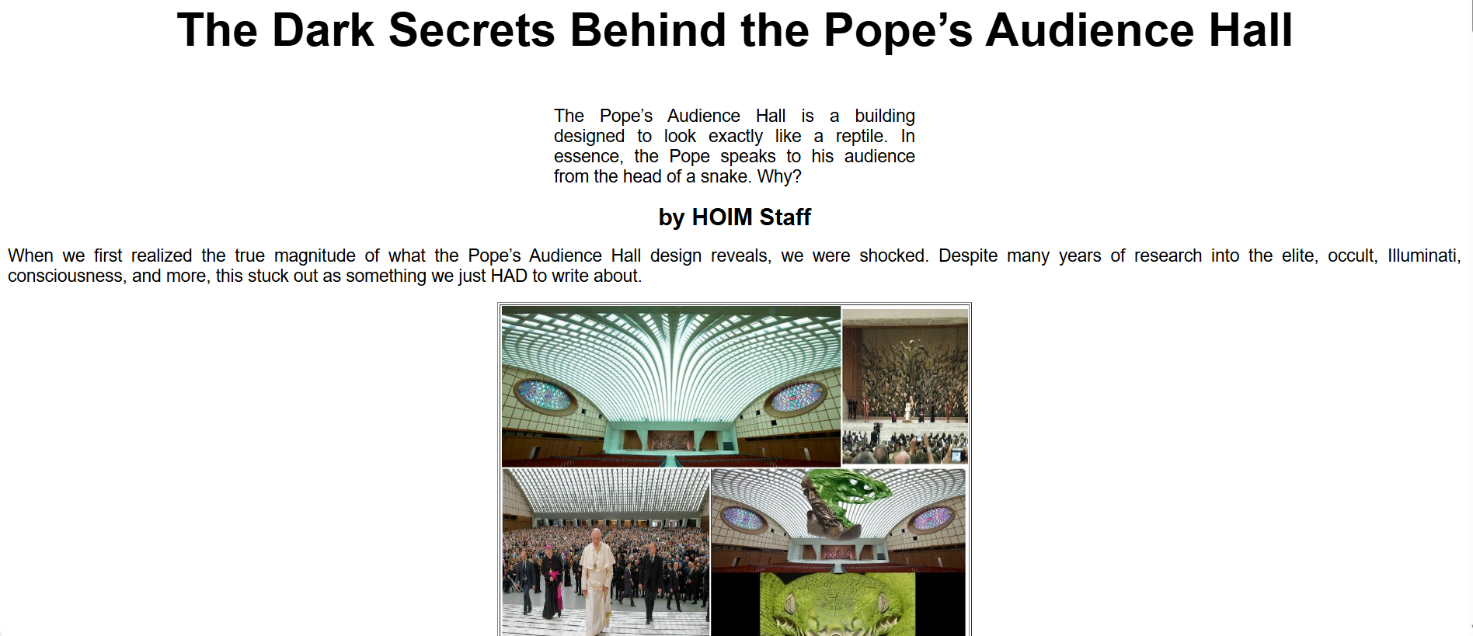
Have you heard of the Pope’s Audience Hall? Also known as the Paul VI Audience Hall or the Hall of the Pontifical Audiences, it lies partially in Vatican City and partially in Rome, Italy. Named after Pope Paul VI and built in 1971 by Italian architect Pier Luigi Nervi, it seats 6,300 and contains a bronze statue called La Resurrezione, designed by Pericle Fazzini, within.
This all sounds pretty straightforward so far, but let’s dive into what makes this building so strange. We’ll start with the less weird, and get progressively weirder as we go.
Building Method and Design
The building was designed with reinforced concrete by well-known architect Pier Luigi Nervi. Nervi is known for simple yet practical designs that are strong and made to last.
The simple curvature of the building might seem unassuming from the outside, but this is part one of what we will begin to explore about this building, and we promise you, by the time we get to the end, you will see what we are getting at.
In this overhead photo, the building stands out for its unusual shape, which is innocuous enough until juxtaposed with a viper’s head.
Have a look at the image below and compare its shape to the image of a snake beside it. Note the overall shape -- wide back, narrow, rounded front, eyes in the middle, nostril at the front, and curved top.
Notice the similarities in the shape, the roofing and scaly skin, and the placement of the eyes.
Windows
As you can already begin to see in the image above, there are two windows on either side of the building that resemble eyes. They are made of stained glass and sit about halfway through the building’s length on either side.
In the center of the eye shape, you begin to see a slit that could resemble a reptile eye. If you’re not convinced yet, which is understandable, keep reading.
Maybe looking at one window on its own isn’t the most clear, so let’s have a look at both of them together now.
All of a sudden we begin to see things taking shape here -- two reptilian eyes, staring at you as you observe the stage.
Scales and Fangs
Have a look again at the image above -- what do you notice down the center? There stands what looks to be a statue in the middle and then on either side, two sharp, pointed fangs. The building’s roof and sides also resemble scales.
Here are two more images to give you a sense of the scales.
Now let’s pull it together a bit more so we can really see what we are looking at. In the image below, really pay attention to the whole building and stage layout next to the image of a snake. The eyes, the shape, the scales, the fangs, the look and feel of the reptile…it’s all there.
The La Resurrezione Statue
In the middle of the stage sits a statue of the Messiah rising from an atomic apocalypse. It was designed by Pericle Fazzini and put in place by 1977. Have a look at it below. Do you notice anything about the Messiah’s head?
Front
Oddly, from almost any angle, the head of the Messiah looks suspiciously like the head of a snake with its fangs open, prepared to bite. It is equally as ghoulish as the snake hall, and also has depictions of reptiles/snakes within the relief surrounding the supposed Messiah.
You will notice that the “head of Christ” has his hair blowing in the breeze or some such thing, but if you look closer it is more than that. The head of the Messiah is turning into…a reptile!
Right side
Left side
It’s difficult to see from the front, but when you view the statue from the sides, where patrons would sit, it becomes strikingly clear from both sides that the head of the Messiah is meant to look like that of a snake.
Think about it for a moment: If just one side of the statue gave the impression of a snake’s head, we could brush this off as coincidence, but when it looks this way from all angles, and the entire building resembles a snake as well, it becomes much more difficult to ignore. One must begin to realize that this was purposefully designed to appear this way. The thought and planning that went into this would have to have been immense.
The reality is -- there is an obvious reason for this imagery.
G.K. Chesterton once referred to architecture as “the most practical and the most dangerous of the arts.” When it comes to the dangerous part of the equation, church-related edifices built with Vatican II mandates in mind should all come with the spiritual equivalent of boarded-up doors and windows, and prominently-displayed “CONDEMNED — KEEP OUT!” signs.
One of the foremost offenders in this regard, and perhaps the creepiest looking of of all, has to be the 6300-seat snake-head-like Hall of the Pontifical Audiences. As construction on it was completed in 1971 during the ill-begotten reign of Giovanni Battista Montini (“Pope” Paul VI), the building is more popularly known as the Paul VI Audience Hall (or the Aula Paolo VI in Italian).
Inside, on the stage behind the seated “pope” is a massive artwork allegedly depicting the Resurrection of Christ. We say “allegedly” because, unlike in conventional renderings, there is no joy to be found in it, no angelic Alleluias! singing the praises of Our Lord’s victory over the grave. Rather, it could more likely be taken for a glimpse into the horrors of hell or perhaps some tragic pagan epic, than it could pass for a scene of Easter glories. Both the hall and the sculpture will be treated in depth momentarily, but first it will be profitable to examine the Novus Ordo justification for such grotesqueries.
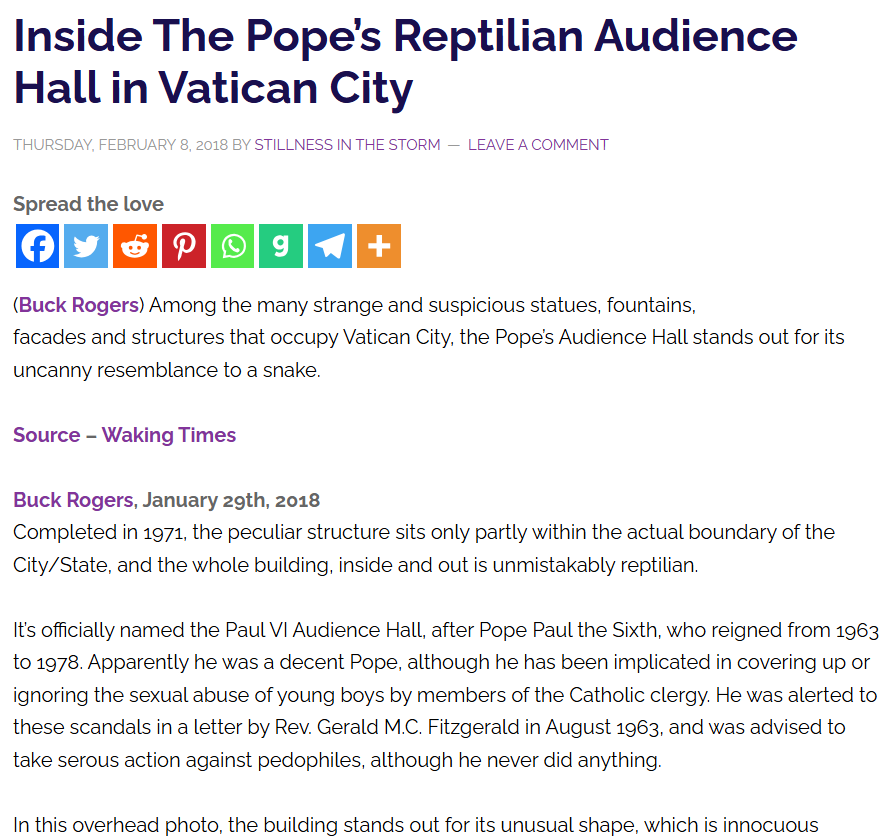
Among the many strange and suspicious statues, fountains, facades and structures that occupy Vatican City, the Pope’s Audience Hall stands out for its uncanny resemblance to a snake. Completed in 1971, the peculiar structure sits only partly within the actual boundary of the City/State, and the whole building, inside and out is unmistakably reptilian.
It’s officially named the Paul VI Audience Hall, after Pope Paul the Sixth, who reigned from 1963 to 1978. Apparently he was a decent Pope, although he has been implicated in covering up or ignoring the sexual abuse of young boys by members of the Catholic clergy. He was alerted to these scandals in a letter by Rev. Gerald M.C. Fitzgerald in August 1963, and was advised to take serous action against pedophiles, although he never did anything.
In this overhead photo, the building stands out for its unusual shape, which is innocuous enough until juxtaposed with a viper’s head.
Notice the similarities in the shape, the roofing and scaly skin, and the placement of eyes
Designed by award-winning Italian architect Pier Luigi Nervi, the building is designed to seat 6300 people for conference with the Pope himself, who presents from a stage in front of a giant Satanic looking sculpture. Named The Resurrection, La Resurrezione, the sculpture was designed by or Pericle Fazzini. and was inspired by the idea of Christ rising from the blast of a nuclear explosion.
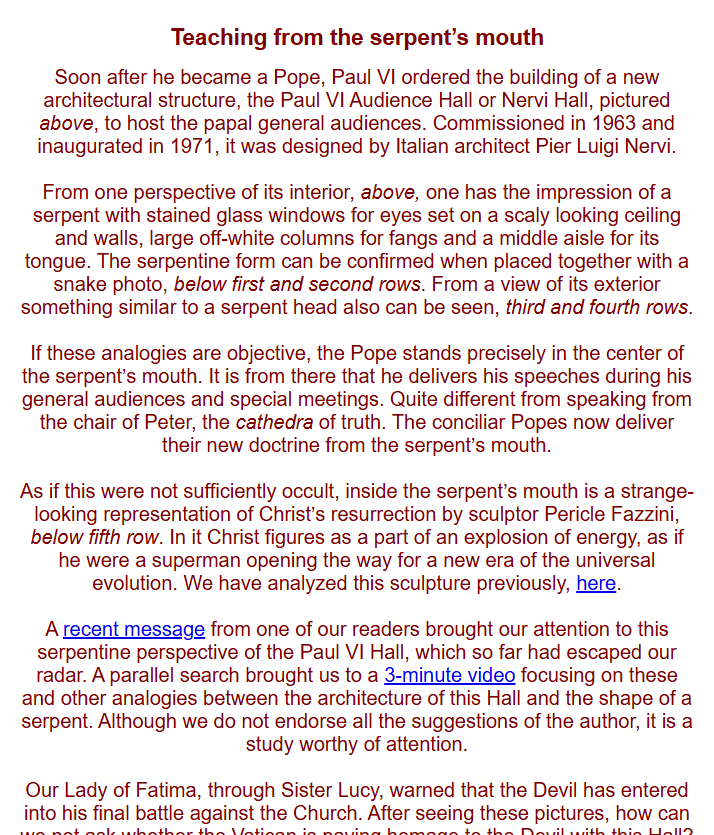
Teaching from the serpent’s mouth
Soon after he became a Pope, Paul VI ordered the building of a new architectural structure, the Paul VI Audience Hall or Nervi Hall, pictured above, to host the papal general audiences. Commissioned in 1963 and inaugurated in 1971, it was designed by Italian architect Pier Luigi Nervi.
From one perspective of its interior, above, one has the impression of a serpent with stained glass windows for eyes set on a scaly looking ceiling and walls, large off-white columns for fangs and a middle aisle for its tongue. The serpentine form can be confirmed when placed together with a snake photo, below first and second rows. From a view of its exterior something similar to a serpent head also can be seen, third and fourth rows.
If these analogies are objective, the Pope stands precisely in the center of the serpent’s mouth. It is from there that he delivers his speeches during his general audiences and special meetings. Quite different from speaking from the chair of Peter, the cathedra of truth. The conciliar Popes now deliver their new doctrine from the serpent’s mouth.
As if this were not sufficiently occult, inside the serpent’s mouth is a strange-looking representation of Christ’s resurrection by sculptor Pericle Fazzini, below fifth row. In it Christ figures as a part of an explosion of energy, as if he were a superman opening the way for a new era of the universal evolution. We have analyzed this sculpture previously, here.
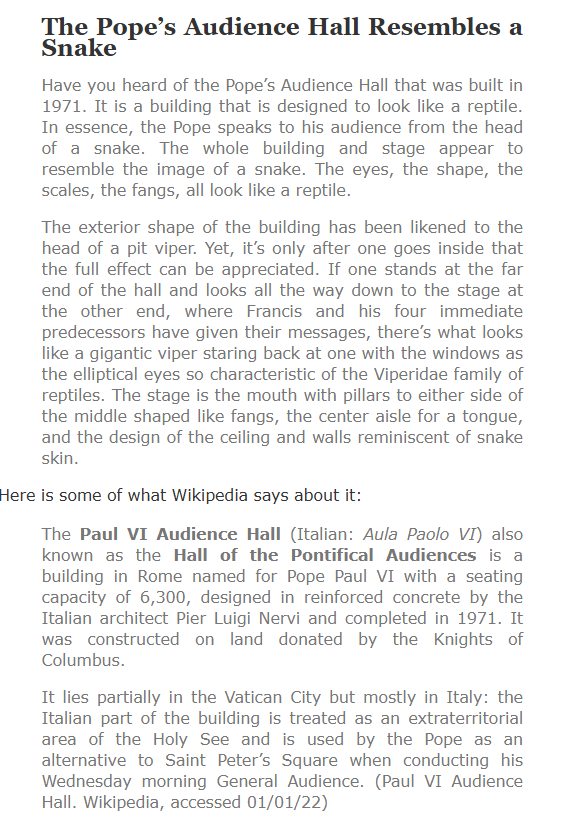
Have you heard of the Pope’s Audience Hall that was built in 1971. It is a building that is designed to look like a reptile. In essence, the Pope speaks to his audience from the head of a snake. The whole building and stage appear to resemble the image of a snake. The eyes, the shape, the scales, the fangs, all look like a reptile.
The exterior shape of the building has been likened to the head of a pit viper. Yet, it’s only after one goes inside that the full effect can be appreciated. If one stands at the far end of the hall and looks all the way down to the stage at the other end, where Francis and his four immediate predecessors have given their messages, there’s what looks like a gigantic viper staring back at one with the windows as the elliptical eyes so characteristic of the Viperidae family of reptiles. The stage is the mouth with pillars to either side of the middle shaped like fangs, the center aisle for a tongue, and the design of the ceiling and walls reminiscent of snake
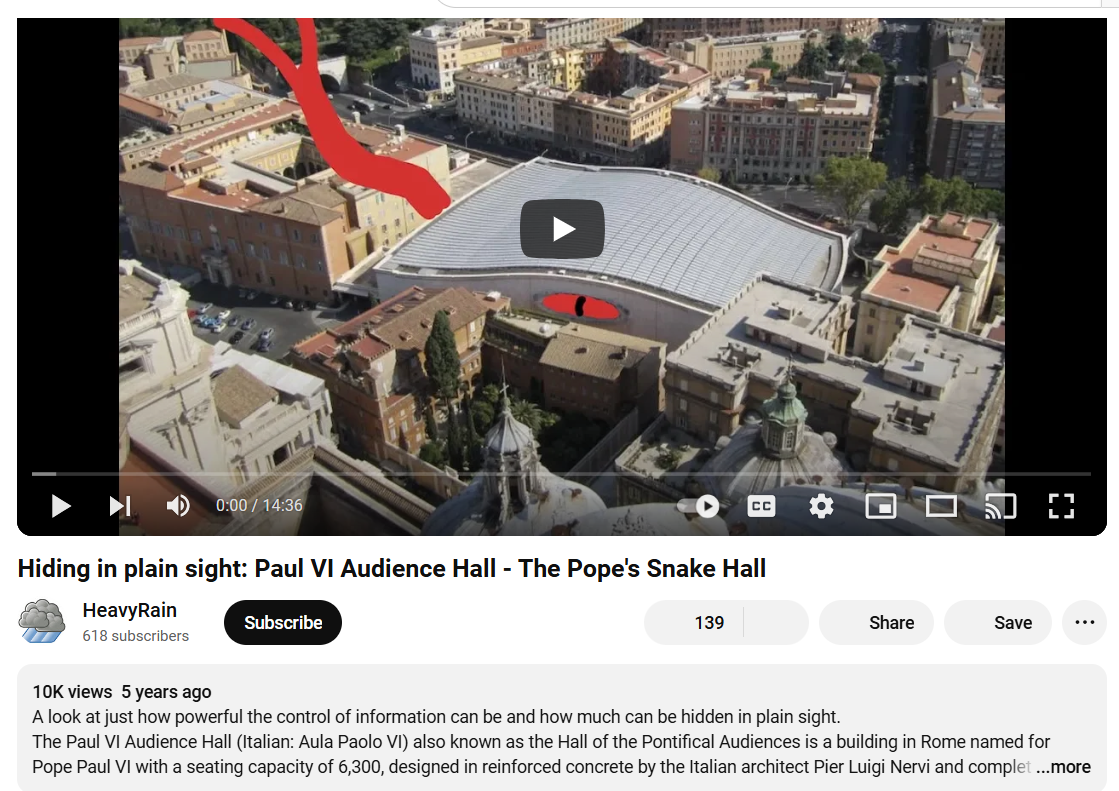
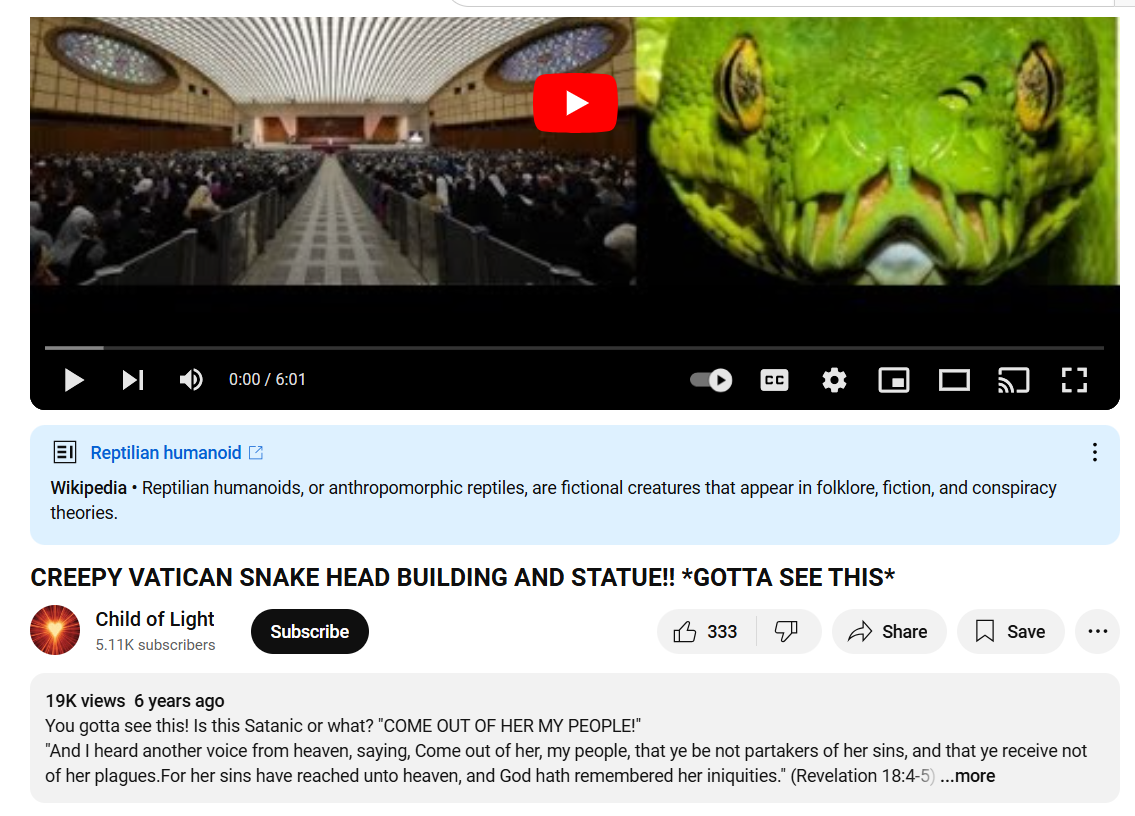
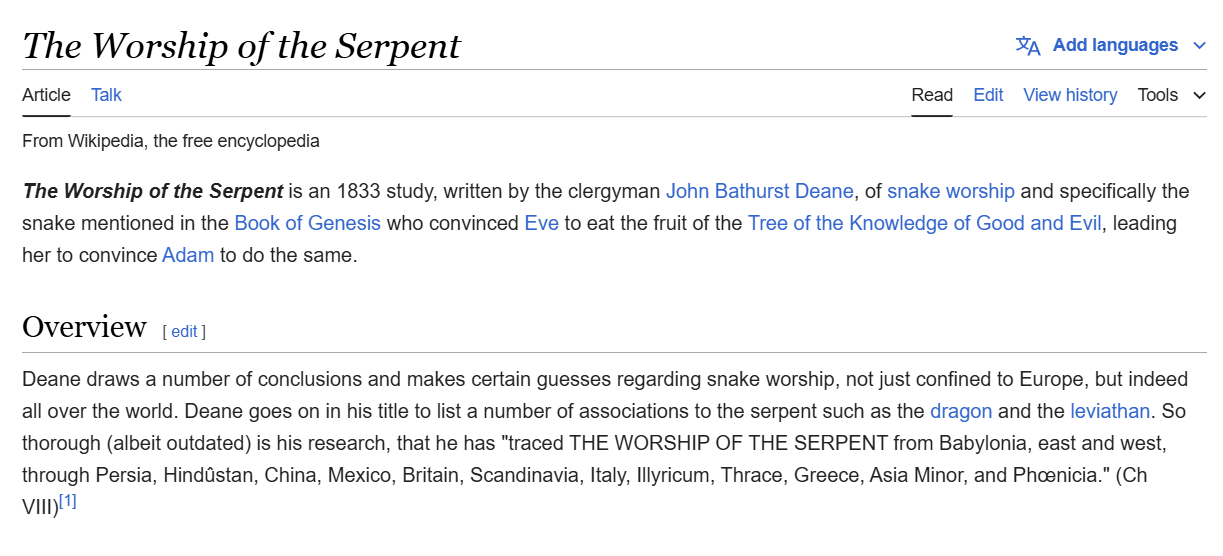
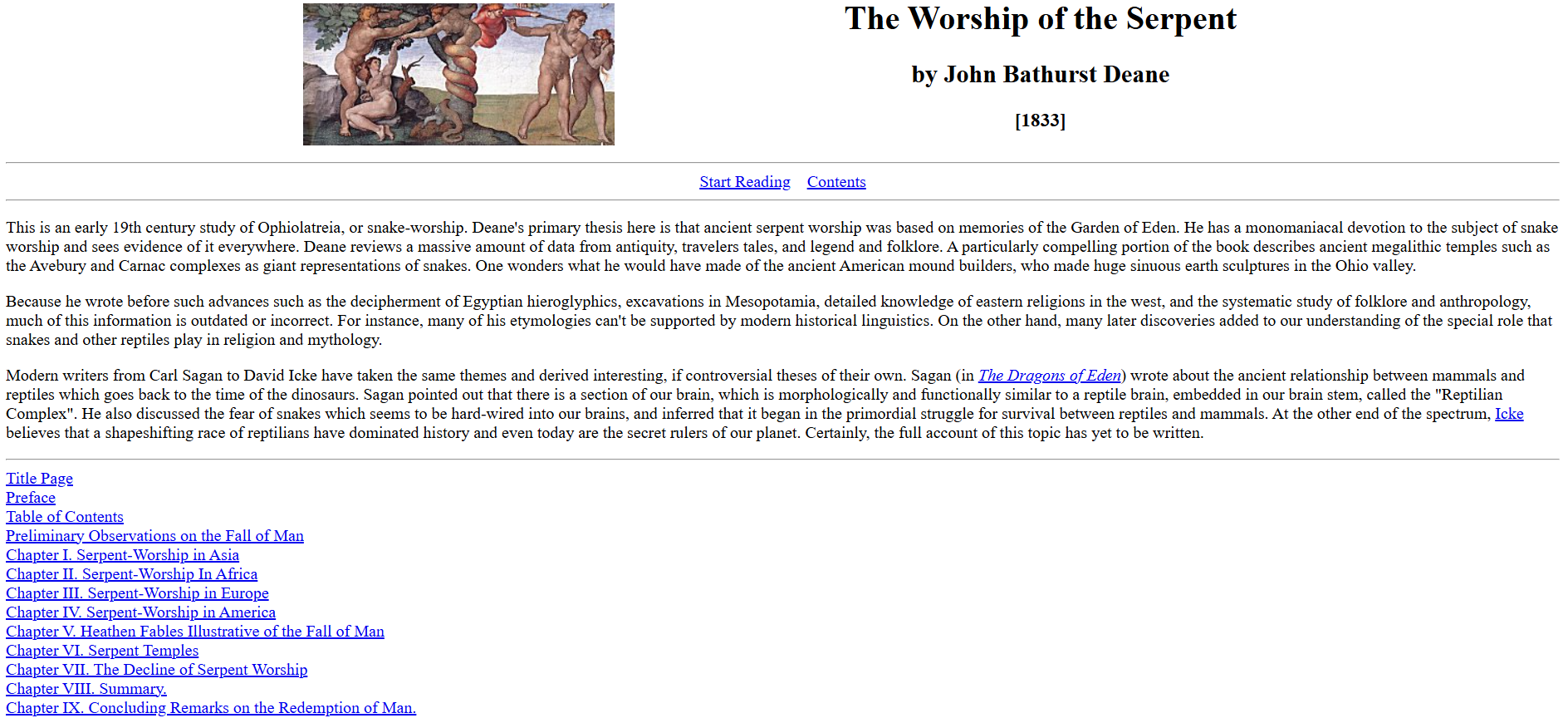
- This is an early 19th century study of Ophiolatreia, or snake-worship. Deane's primary thesis here is that ancient serpent worship was based on memories of the Garden of Eden. He has a monomaniacal devotion to the subject of snake worship and sees evidence of it everywhere. Deane reviews a massive amount of data from antiquity, travelers tales, and legend and folklore. A particularly compelling portion of the book describes ancient megalithic temples such as the Avebury and Carnac complexes as giant representations of snakes. One wonders what he would have made of the ancient American mound builders, who made huge sinuous earth sculptures in the Ohio valley.
- Because he wrote before such advances such as the decipherment of Egyptian hieroglyphics, excavations in Mesopotamia, detailed knowledge of eastern religions in the west, and the systematic study of folklore and anthropology, much of this information is outdated or incorrect. For instance, many of his etymologies can't be supported by modern historical linguistics. On the other hand, many later discoveries added to our understanding of the special role that snakes and other reptiles play in religion and mythology.
- Title Page
Preface
Table of Contents
Preliminary Observations on the Fall of Man
Chapter I. Serpent-Worship in Asia
Chapter II. Serpent-Worship In Africa
Chapter III. Serpent-Worship in Europe
Chapter IV. Serpent-Worship in America
Chapter V. Heathen Fables Illustrative of the Fall of Man
Chapter VI. Serpent Temples
Chapter VII. The Decline of Serpent Worship
Chapter VIII. Summary.
Chapter IX. Concluding Remarks on the Redemption of Man.
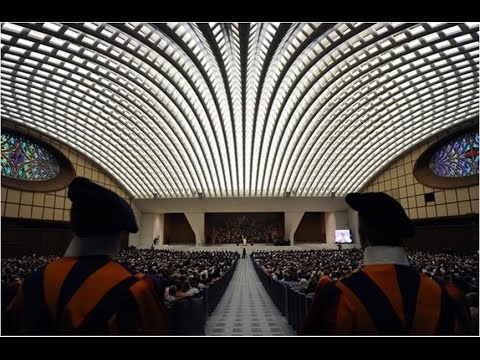
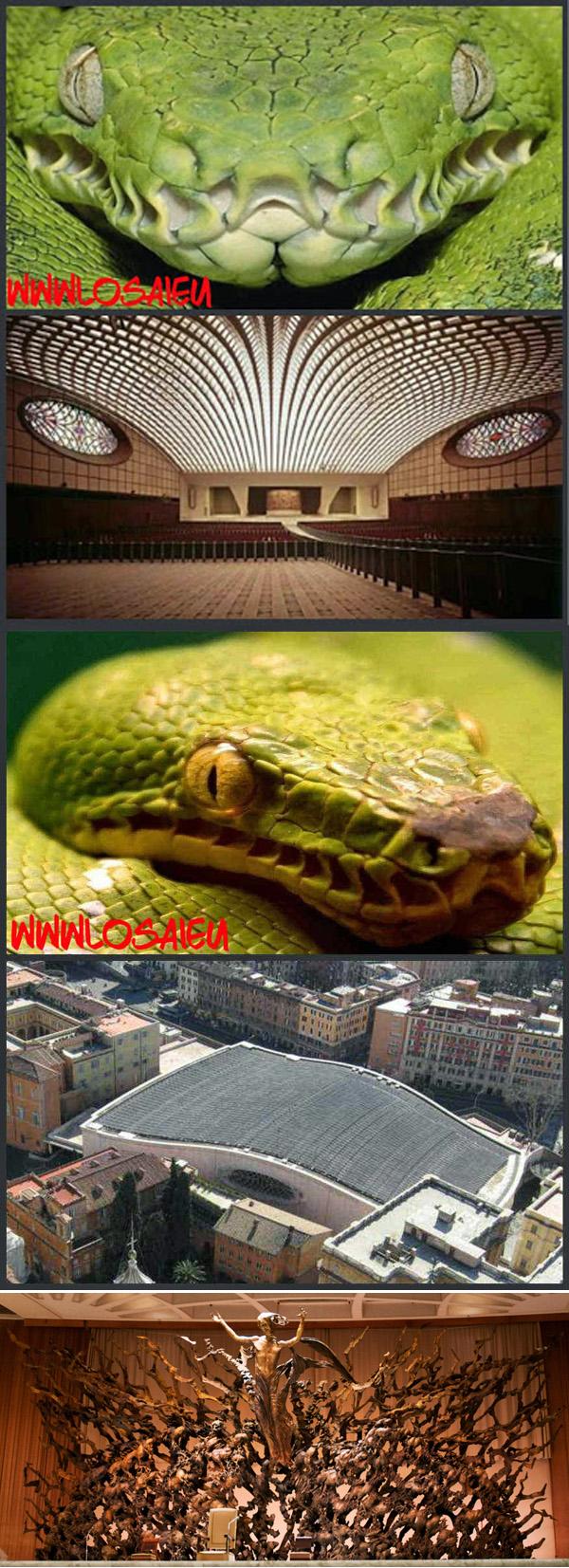
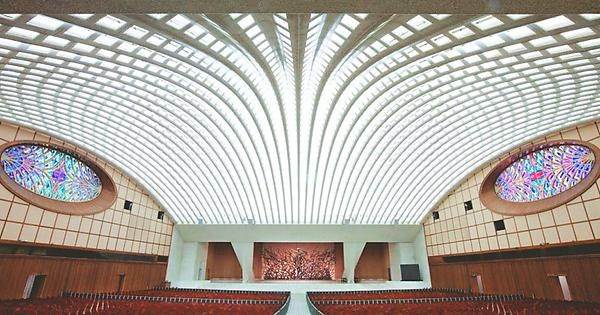
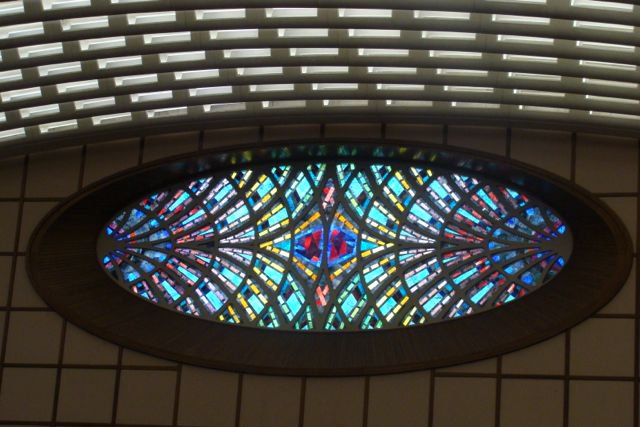

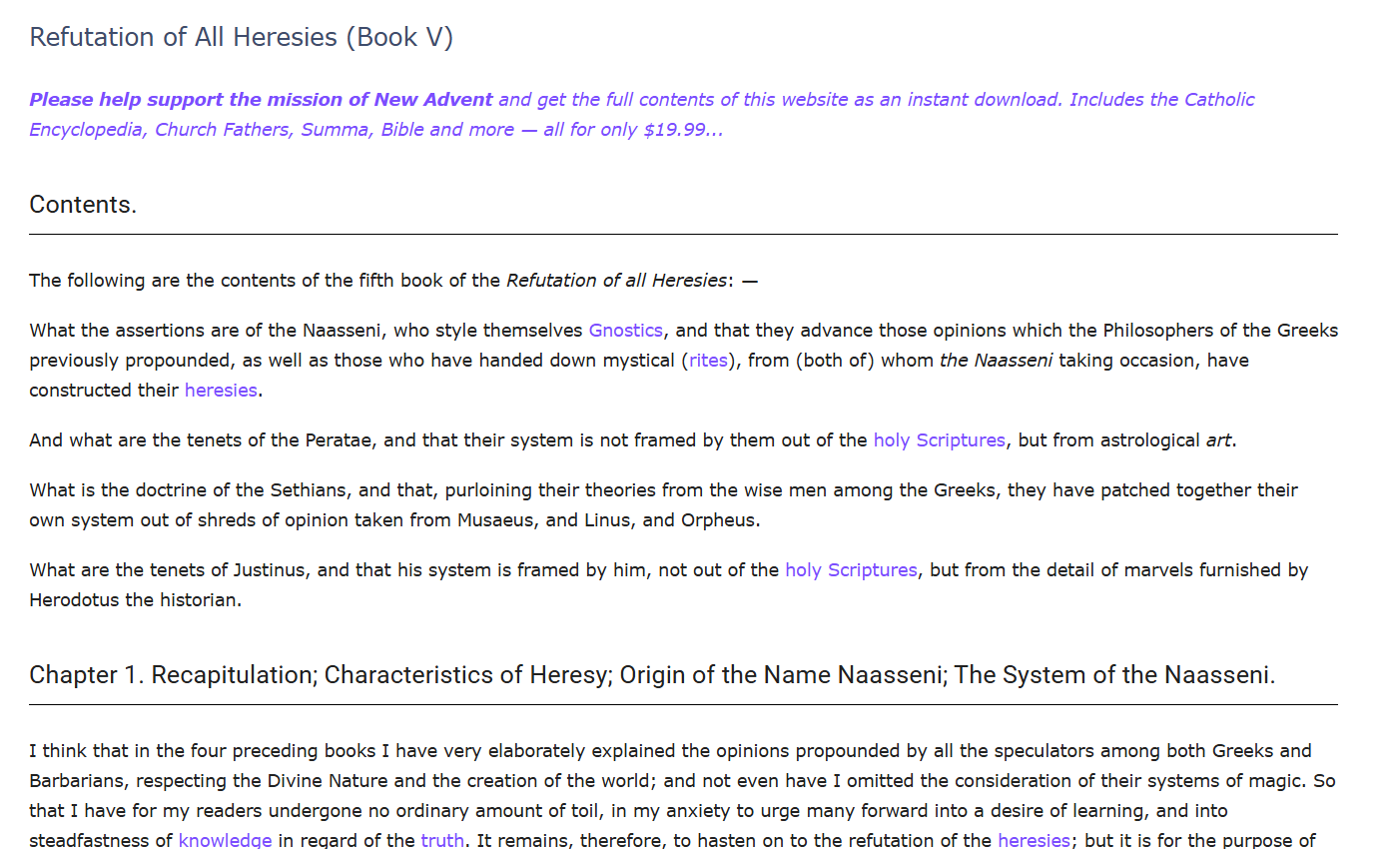
What the assertions are of the Naasseni, who style themselves Gnostics, and that they advance those opinions which the Philosophers of the Greeks previously propounded, as well as those who have handed down mystical (rites), from (both of) whom the Naasseni taking occasion, have constructed their heresies.
And what are the tenets of the Peratae, and that their system is not framed by them out of the holy Scriptures, but from astrological art.
What is the doctrine of the Sethians, and that, purloining their theories from the wise men among the Greeks, they have patched together their own system out of shreds of opinion taken from Musaeus, and Linus, and Orpheus.
What are the tenets of Justinus, and that his system is framed by him, not out of the holy Scriptures, but from the detail of marvels furnished by Herodotus the historian.
Mysteries Allegorized by the Naasseni
These are the heads of very numerous discourses which (the Naassene) asserts James the brother of the Lord handed down to Mariamne. In order, then, that these impious (heretics) may no longer belie Mariamne or James, or the Saviour Himself, let us come to the mystic rites (whence these have derived their figment) — to a consideration, if it seems right, of both the Barbarian and Grecian (mysteries) — and let us see how these (heretics), collecting together the secret and ineffable mysteries of all the Gentiles, are uttering falsehoods against Christ, and are making dupes of those who are not acquainted with these orgies of the Gentiles. For since the foundation of the doctrine with them is the man Adam, and they say that concerning him it has been written, Who shall declare his generation? Isaiah 53:8 learn how, partly deriving from the Gentiles the undiscoverable and diversified generation of the man, they fictitiously apply it to Christ.
Now earth, say the Greeks, gave forth a man, (earth) first bearing a goodly gift, wishing to become mother not of plants devoid of sense, nor beasts without reason, but of a gentle and highly favoured creature. It, however, is difficult, (the Naassene) says, to ascertain whether Alalcomeneus, first of men, rose upon the Boeotians over Lake Cephisus; or whether it were the Idaean Curetes, a divine race; or the Phrygian Corybantes, whom first the sun beheld springing up after the manner of the growth of trees; or whether Arcadia brought forth Pelasgus, of greater antiquity than the moon; or Eleusis (produced) Diaulus, an inhabitant of Raria; or Lemnus begot Cabirus, fair child of secret orgies; or Pallene (brought forth) the Phlegraean Alcyoneus, oldest of the giants. But the Libyans affirm that Iarbas, first born, on emerging from arid plains, commenced eating the sweet acorn of Jupiter. But the Nile of the Egyptians, he says, up to this day fertilizing mud, (and therefore) generating animals, renders up living bodies, which acquire flesh from moist vapour. The Assyrians, however, say that fish-eating Oannes was (the first man, and) produced among themselves. The Chaldeans, however, say that this Adam is the man whom alone earth brought forth. And that he lay inanimate, unmoved, (and) still as a statue; being an image of him who is above, who is celebrated as the man Adam, having been begotten by many powers, concerning whom individually is an enlarged discussion.
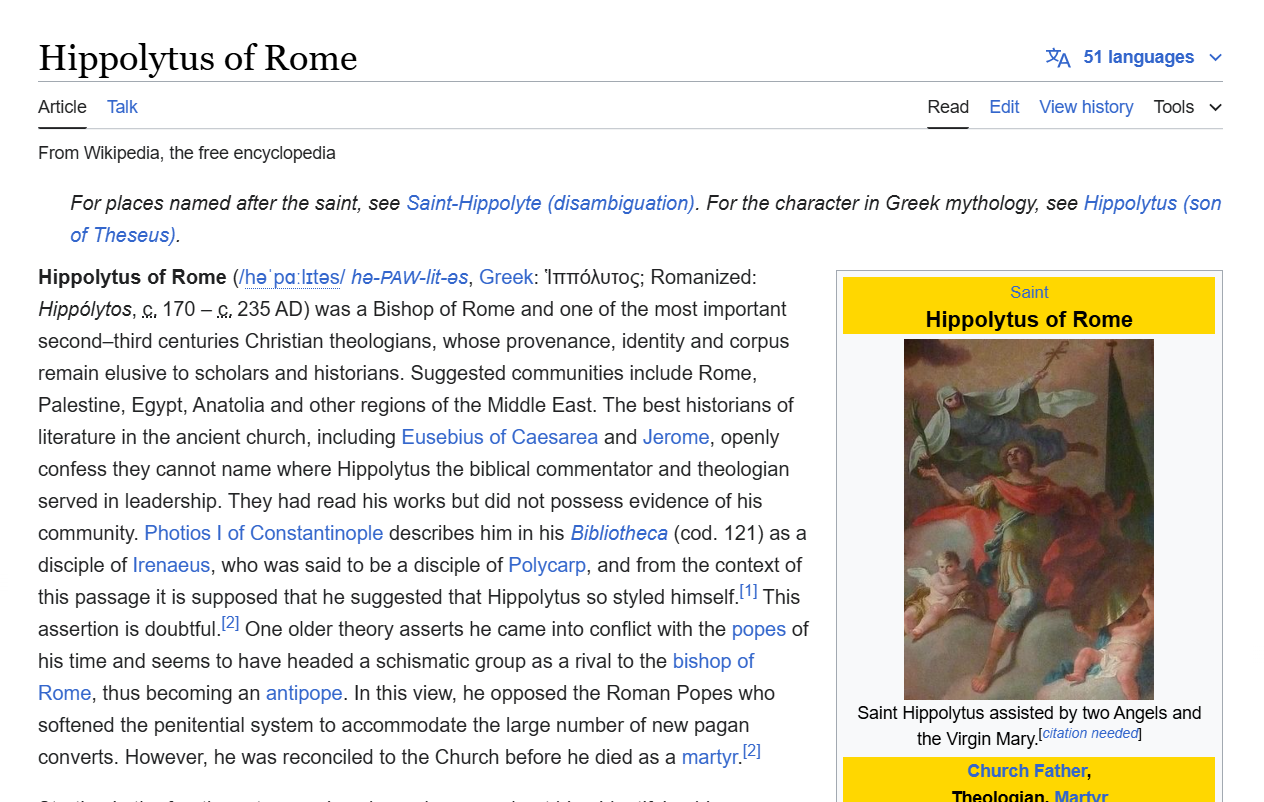
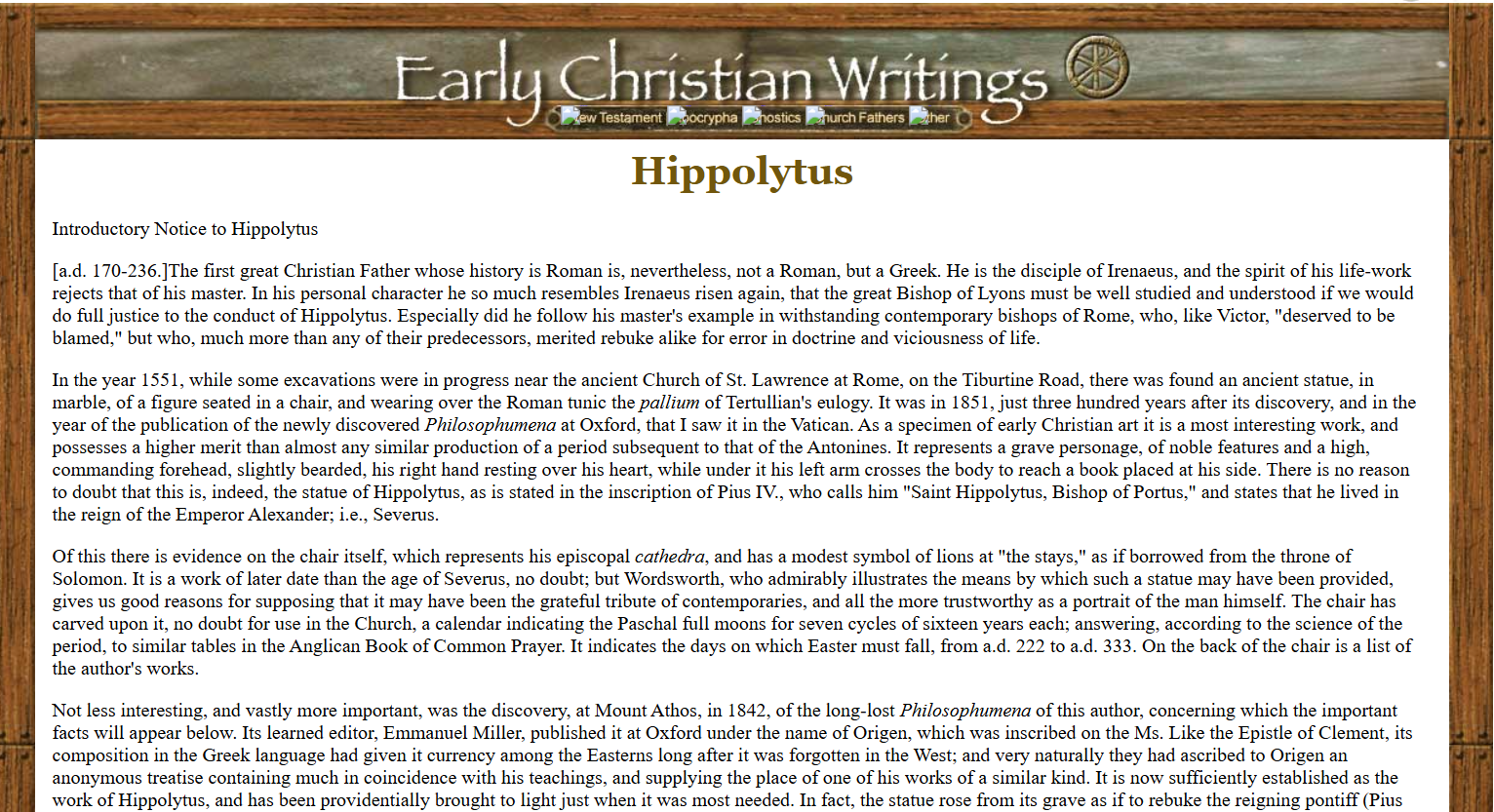
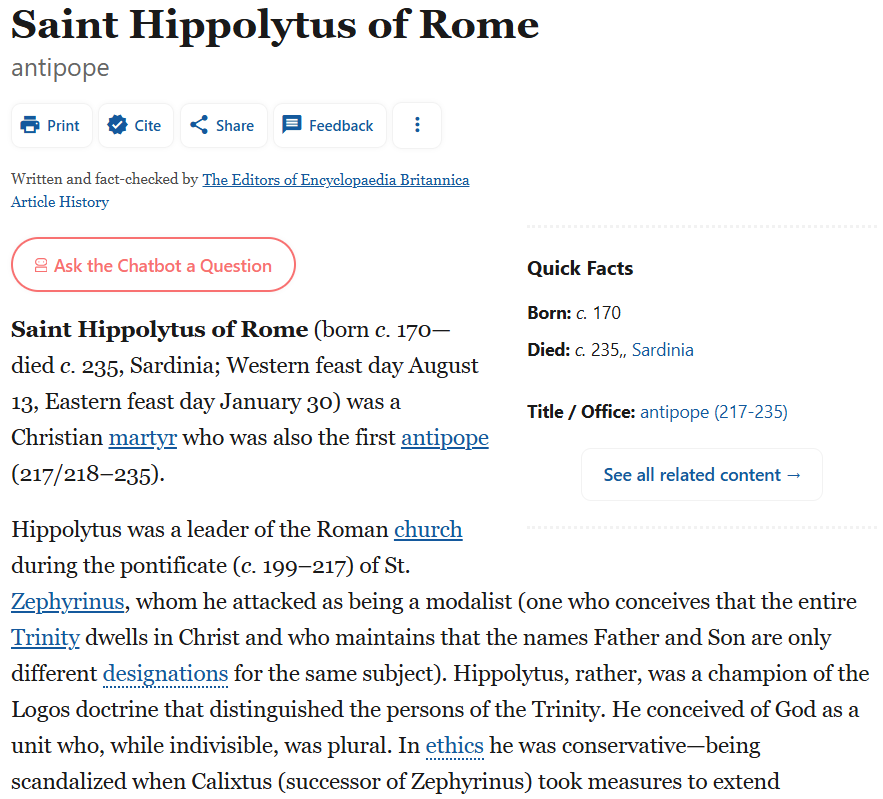
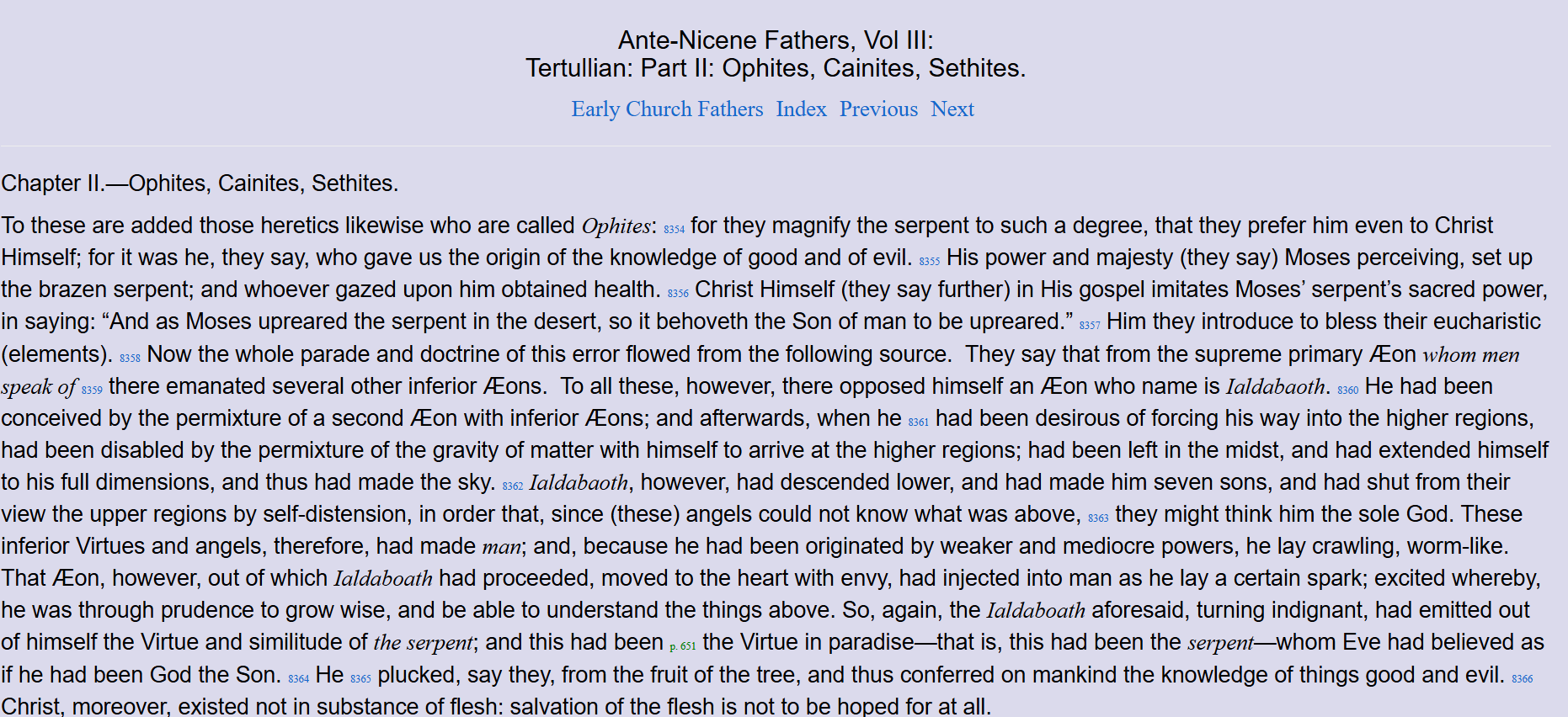
Chapter II.—Ophites, Cainites, Sethites.
To these are added those heretics likewise who are called Ophites: 8354 for they magnify the serpent to such a degree, that they prefer him even to Christ Himself; for it was he, they say, who gave us the origin of the knowledge of good and of evil. 8355 His power and majesty (they say) Moses perceiving, set up the brazen serpent; and whoever gazed upon him obtained health. 8356 Christ Himself (they say further) in His gospel imitates Moses’ serpent’s sacred power, in saying: “And as Moses upreared the serpent in the desert, so it behoveth the Son of man to be upreared.” 8357 Him they introduce to bless their eucharistic (elements). 8358 Now the whole parade and doctrine of this error flowed from the following source. They say that from the supreme primary Æon whom men speak of 8359 there emanated several other inferior Æons. To all these, however, there opposed himself an Æon who name is Ialdabaoth. 8360 He had been conceived by the permixture of a second Æon with inferior Æons; and afterwards, when he 8361 had been desirous of forcing his way into the higher regions, had been disabled by the permixture of the gravity of matter with himself to arrive at the higher regions; had been left in the midst, and had extended himself to his full dimensions, and thus had made the sky. 8362 Ialdabaoth, however, had descended lower, and had made him seven sons, and had shut from their view the upper regions by self-distension, in order that, since (these) angels could not know what was above, 8363 they might think him the sole God. These inferior Virtues and angels, therefore, had made man; and, because he had been originated by weaker and mediocre powers, he lay crawling, worm-like. That Æon, however, out of which Ialdaboath had proceeded, moved to the heart with envy, had injected into man as he lay a certain spark; excited whereby, he was through prudence to grow wise, and be able to understand the things above. So, again, the Ialdaboath aforesaid, turning indignant, had emitted out of himself the Virtue and similitude of the serpent; and this had been p. 651 the Virtue in paradise—that is, this had been the serpent—whom Eve had believed as if he had been God the Son. 8364 He 8365 plucked, say they, from the fruit of the tree, and thus conferred on mankind the knowledge of things good and evil. 8366 Christ, moreover, existed not in substance of flesh: salvation of the flesh is not to be hoped for at all.
Moreover, also, there has broken out another heresy also, which is called that of the Cainites. 8367 And the reason is, that they magnify Cain as if he had been conceived of some potent Virtue which operated in him; for Abel had been procreated after being conceived of an inferior Virtue, and accordingly had been found inferior. They who assert this likewise defend the traitor Judas, telling us that he is admirable and great, because of the advantages he is vaunted to have conferred on mankind; for some of them think that thanksgiving is to be rendered to Judas on this account: viz., Judas, they say, observing that Christ wished to subvert the truth, betrayed Him, in order that there might be no possibility of truth’s being subverted. And others thus dispute against them, and say: Because the powers of this world 8368 were unwilling that Christ should suffer, lest through His death salvation should be prepared for mankind, he, consulting for the salvation of mankind, betrayed Christ, in order that there might be no possibility at all of the salvation being impeded, which was being impeded through the Virtues which were opposing Christ’s passion; and thus, through the passion of Christ, there might be no possibility of the salvation of mankind being retarded.
But, again, the heresy has started forth which is called that of the Sethites. 8369 The doctrine of this perversity is as follows. Two human beings were formed by the angels—Cain and Abel. On their account arose great contentions and discords among the angels; for this reason, that Virtue which was above all the Virtues—which they style the Mother—when they said 8370 that Abel had been slain, willed this Seth of theirs to be conceived and born in place of Abel, in order that those angels might be escheated who had created those two former human beings, while this pure seed rises and is born. For they say that there had been iniquitous permixtures of two angels and human beings; for which reason that Virtue which (as we have said) they style the Mother brought on the deluge even, for the purpose of vengeance, in order that that seed of permixture might be swept away, and this only seed which was pure be kept entire. But (in vain): for they who had originated those of the former seed sent into the ark (secretly and stealthily, and unknown to that Mother-Virtue), together with those “eight souls,” 8371 the seed likewise of Ham, in order that the seed of evil should not perish, but should, together with the rest, be preserved, and after the deluge be restored to the earth, and, by example of the rest, should grow up and diffuse itself, and fill and occupy the whole orb. 8372 Of Christ, moreover, their sentiments are such that they call Him merely Seth, and say that He was instead of the actual Seth.